Intermec Technologies DRCB DRCB User Manual CN2 Handheld Computer User s Manual
Intermec Technologies Corporation DRCB CN2 Handheld Computer User s Manual
Contents
Users Manual 3 of 3

CN2 Handheld Computer User’s Manual 33
Configuring the CN2
Use this chapter to understand how to configure the CN2. In
this chapter, you will find these sections:
• How to Configure the CN2 Parameters
• Configuring the CN2 With the Setup Assistant
• Configuring the CN2 Locally With Intermec Setting
• Configuring the CN2 Remotely With Intermec Settings
• Customizing the Keypad
2
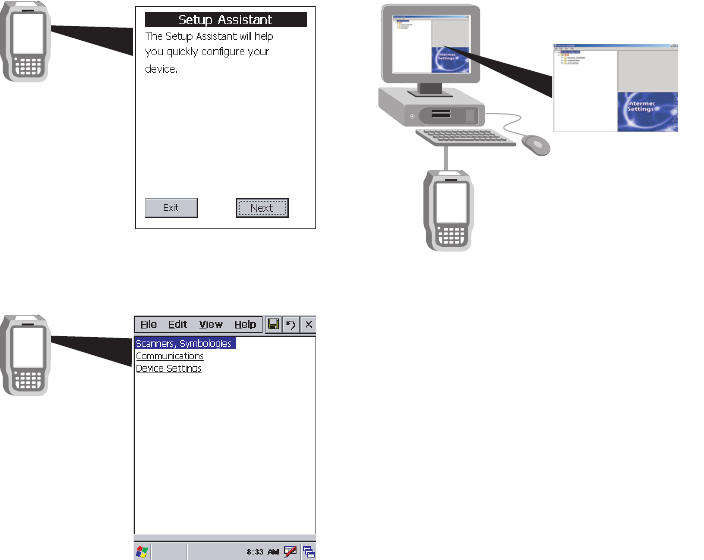
Chapter 2 — Configuring the CN2
34 CN2 Handheld Computer User’s Manual
How to Configure the CN2 Parameters
You can configure many parameters on the CN2, such as the bar
code symbologies it decodes or the network settings. These
characteristics are controlled by configuration parameters. The
values you set for these configuration parameters determine how
the computer operates.
There are several ways to configure the CN2:
Use Setup Assistant
Use Intermec Settings Locally
Use Intermec
Settings on
the CN2 to
set most
parameters.
Use Setup
Assistant to
quickly enter
network
parameters.
Use Intermec Settings Remotely
Use Intermec Settings
on your desktop PC to
remotely configure
network parameters.
Configuring the CN2: The CN2 provides several ways for you to configure the communications,
device, and imaging parameters.
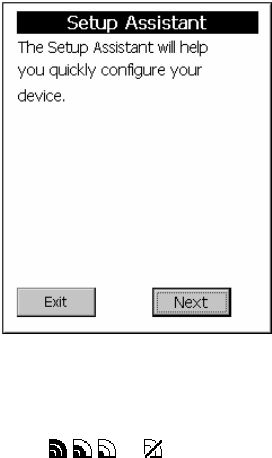
Chapter 2 — Configuring the CN2
CN2 Handheld Computer User’s Manual 35
Configuring the CN2 With the Setup Assistant
The Setup Assistant runs on the CN2 the first time you turn on
the computer. Use the Setup Assistant to set or enable basic
network parameters and connect your CN2 to the network. The
Setup Assistant guides you through setting the following basic
network parameters:
• Date and time
• 802.11b/g radio and SSID (Network name)
• 802.1x security
• DHCP server or IP address, subnet mask, and default router
• Primary and secondary DNS addresses
• Primary and secondary WINS addresses
• Device name
To set other parameters, use Intermec Settings or another
configuration method.
The Setup Assistant Start Screen
After you complete the Setup Assistant, the CN2 should be
communicating with your network. A Network Connection
icon ( or ) appears on your taskbar. For more
information on the network icons, see “Understanding the
Screen Icons” on page 19.

Chapter 2 — Configuring the CN2
36 CN2 Handheld Computer User’s Manual
Configuring the CN2 Locally With Intermec Settings
Use Intermec Settings to configure the CN2 and view system
information. You can access Intermec Settings while running
any application.
Opening Intermec Settings
To open Intermec Settings
1 Tap the Start icon. The Start menu appears.
2 Tap Intermec Settings. The Intermec Settings application
appears.

Chapter 2 — Configuring the CN2
CN2 Handheld Computer User’s Manual 37
3 Make changes to the settings as necessary. For help, see the
next section, “Navigating Through Intermec Settings.”
4 Save your changes. For help, see “Saving Your Settings” on
page 39.
5 Exit Intermec Settings. For help, see “Exiting Intermec
Settings” on page 39.
Navigating Through Intermec Settings
Use this table to understand how to navigate and enter
information in Intermec Settings.
Navigating in Intermec Settings
Function Choose a Method
Select or expand an
option
• Tap the option.
• On the scroll keypad, press U or D to
select an option.
Expand an option • Tap the option.
• On the scroll keypad, press U or D to
select the option, and then press R.
Enter information • Tap in the text box. The soft keyboard
appears. Tap the keyboard keys to enter
information. Tap outside the box or tap
Enter when you are finished.
Select text in a text
box
• Tap in the text box and drag the stylus
over the text.
Save settings • Tap File > Save Settings.
• Tap the Save icon in the upper right
corner.
Use the following diagram to help find the commands you need
to use to configure your CN2. These screens do not represent
the exact information you will see on your CN2. They have
been modified to show you how the information is structured.
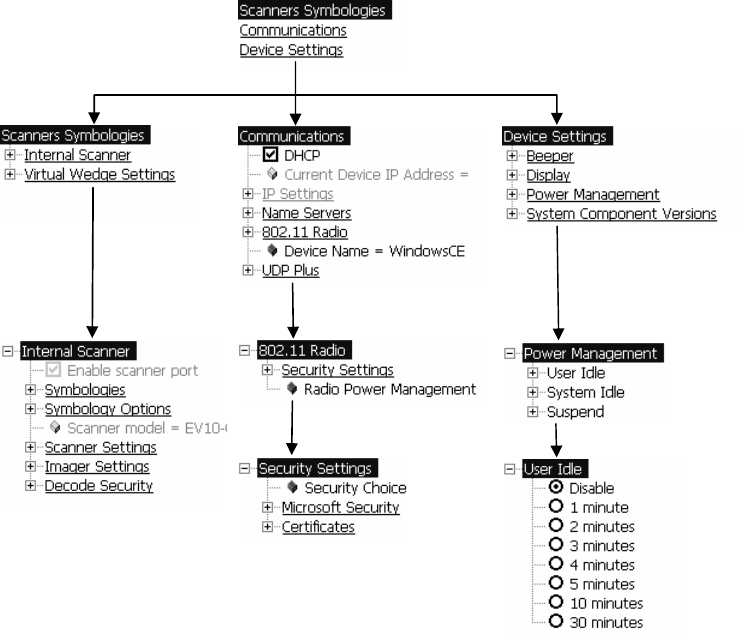
Chapter 2 — Configuring the CN2
38 CN2 Handheld Computer User’s Manual
Intermec Settings Menus: Use this diagram to help navigate through the Intermec Settings
application. This diagram should only be used as a guide; it does not accurately represent all of the
information you will see on your screen.
Learning About the Configuration Commands in Intermec Settings
For detailed information on most of the commands available in
Intermec Settings, see the Intermec Computer Command
Reference Manual (P/N 073529).
A copy of this online manual is on the CD attached inside the
front cover of this user’s manual. You should check the Intermec
web site at www.intermec.com to determine if a more recent
version is available for download.

Chapter 2 — Configuring the CN2
CN2 Handheld Computer User’s Manual 39
Saving Your Settings
You can save the changes you make in Intermec Settings at any
time. After you save your changes, you can continue making
changes or you can exit Intermec Settings.
To save your settings
• Tap the Save icon at the top of the screen.
Or,
• From the Main Menu, tap File > Save Settings.
Exiting Intermec Settings
When you are done modifying your device configuration and
have saved your settings, you should exit Intermec Settings.
To exit Intermec Settings
• Tap the X in the upper right corner of the window.
Or,
• From the Main Menu, tap File > Exit.
If you try to exit Intermec Settings without saving your changes,
a message box appears asking if you want to save your
configuration changes. Tap Yes.
Restoring the CN2 Default Settings
You can restore the CN2 to factory default settings.
Note: Restoring the CN2 to factory default settings resets all
network parameters. As a result, you may lose network
communications. This option should only be used by network
administrators or by Intermec support personnel.
For a complete list of the default settings, see “Default
Configuration” on page 120.
To restore default settings
1 Tap Start > Intermec Settings. The Intermec Settings
application appears.

Chapter 2 — Configuring the CN2
40 CN2 Handheld Computer User’s Manual
2 Tap one of the menus:
• Scanners Symbologies
• Communications
• Device Settings
3 Tap Edit > Restore Item Defaults.
4 Tap Yes to restore all default settings.
5 Repeats Steps 2, 3, and 4 for the other two menus.
6 Tap Scanners Symbologies > Internal Scanner >
Symbologies and make sure every bar code symbology that
you need is enabled.
7 Tap to save your settings.
8 Tap X to exit Intermec Settings.
Note: You can also return the CN2 to its default software
configuration by resetting the registry and clearing the object
store. For instructions, see page 96.
Configuring the CN2 Remotely With Intermec Settings
You can use Intermec Settings remotely to configure your CN2.
The remote version of Intermec Settings provides these features:
• Intermec Settings can configure CN2s one-to-one through an
ActiveSync connection.
• Intermec Settings can run as a plug-in to the Wavelink
Avalanche device management system. Avalanche automates
device management within a network and lets you install,
update, and manage the software and configurations of
wireless and other devices.
The ActiveSync (one-to-one) version of Intermec Settings is
available from the Intermec web site as part of the Intermec
Developer’s Library (IDL) download or from the IDL CD. For
information on installing ActiveSync and establishing a
partnership, see “Installing Applications Using ActiveSync” on
page 85.

Chapter 2 — Configuring the CN2
CN2 Handheld Computer User’s Manual 41
For more help using Intermec Settings, see the online manual
available from the Help menu in Intermec Settings.
Customizing the Keypad
You can customize how the numeric and scroll keypads operate:
• You can configure the CN2 to click when you press any key.
• You can configure the CN2 to click when a character is
“emitted.” For example, to emit the lowercase b character,
you press 2 2.
• You can disable access to Task Manager by disabling the
keypad shortcut, which is the only way to start Task
Manager. To learn the shortcut for your keypad, see “Using
Task Manager to Manage Multiple Active Tasks” on page 22.
• You can disable the Power button so users cannot turn off
the CN2. This is useful if you have installed the CN2 in a
kiosk environment.
There are three ways to customize the CN2 keypad:
• You can use the Control Panel on your CN2 to configure
keyboard options. For help, see the next section, “Using the
Control Panel to Customize the Keypad.”
• You can use a registry editing program to change the keypad
registry entries. For help, see “Using a Registry Editing
Program to Customize the Keypad” on page 43.
• You can write an application to change the keypad registry
entries. For help, see “Writing an Application to Customize
the Keypad” on page 44.
Using the Control Panel to Customize the Keypad
You can customize the keypad on a CN2 by making selections at
the Keyboard Properties screen, which you access through the
Control Panel.
This method is convenient for customizing one CN2. To
customize many CN2s, follow the steps in “Writing an
Application to Customize the Keypad” on page 44.
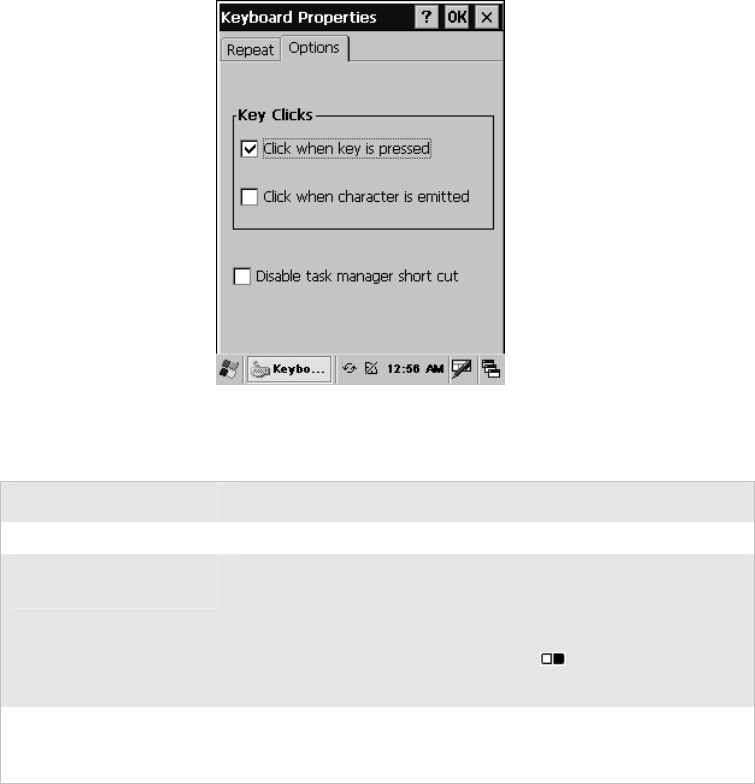
Chapter 2 — Configuring the CN2
42 CN2 Handheld Computer User’s Manual
To customize the keypad
1 Go to Start > Settings > Control Panel.
2 Double-tap the Keyboard icon. The Keyboard Properties
screen appears.
3 Tap the Options tab.
4 Check the box for each option you want to enable.
Summary of Options
Option If You Check This Option
Click when key is pressed You hear a keyclick every time you press a key.
Click when character is
emitted
You hear a keyclick when a character is emitted. For example:
• You hear a keyclick when you press 2 and a 2 character
appears on the screen.
• You hear a keyclick when you press 2 2 and a lowercase b
character appears on the screen.
Disable task manager
short cut
You cannot start Task Manager. You have disabled the keypad
shortcut for starting Task Manager, as described in “Using the
Task Manager to Manage Multiple Active Tasks” on page 22.

Chapter 2 — Configuring the CN2
CN2 Handheld Computer User’s Manual 43
5 Click OK to save your changes and exit the Keyboard
Properties screen.
6 Tap X to exit the Control Panel. The changes take effect
immediately. You do not need to warm boot the CN2.
Using a Registry Editing Program to Customize the Keypad
You can use a registry editing program to display and change the
keypad registry entries, which control how the CN2 keypad
operates. The registry entries are described in the next table,
“CN2 Keypad Registry Entries.”
You can run the Microsoft eMbedded Visual C++® Remote
Registry Editor on your PC, using ActiveSync to connect to the
CN2. Or you can download and run a third-party registry
editing program on your CN2.
After you make your changes, you need to warm boot the CN2
for the changes to take effect. For help, see “Warm Booting the
CN2” on page 104.
The CN2 keypad registry settings are located in
HKEY_LOCAL_MACHINE\Drivers\Keypad.
CN2 Keypad Registry Entries
Registry Entry Default Description
ClickOnPress 1 When this registry entry is set to 1, a keyclick is generated
when the user presses a key.
ClickOnChar 0 When this registry entry is set to 1, a keyclick is generated
when the CN2 emits a character. For numeric keys, the
behavior is the same as ClickOnPress. For alpha-mode, a
keyclick is generated when the character is emitted. For
example, you press 2 2 to emit the b character and
generate the keyclick.
DisableTaskMan 0 When this registry entry is set to 0, the user can start the
Task Manager, as described in “Using the Task Manager to
Manage Multiple Active Tasks” on page 22.
When this registry entry is set to 1, the user cannot start
the Task Manager.
IgnorePowerButton 0 When this registry entry is set to 1, the Power button is
ignored. The user cannot turn off the CN2.
Chapter 2 — Configuring the CN2
44 CN2 Handheld Computer User’s Manual
Writing an Application to Customize the Keypad
You can write an application to change the keypad registry
entries, which are described in the previous table, “CN2 Keypad
Registry Entries.” An application gives you a convenient way to
customize multiple CN2s.
For help downloading and using the Intermec SDK, see
“Developing a New Application” on page 82.
Make sure you application sets the named event
KeybdSettingsChangeEvent after you change the registry entries,
for the changes to take effect.

CN2 Handheld Computer User’s Manual 45
Adding the CN2 to the
Network
Use this chapter to understand how to configure the CN2 to
communicate in your network. In this chapter, you will find
these sections:
• Configuring the CN2 for Your Network
• Configuring Network Security
• Viewing Wireless Network Information
• Allowing FTP File Transfers To and From the CN2
• Using the Modem Dock for Internet Access and E-mail
3
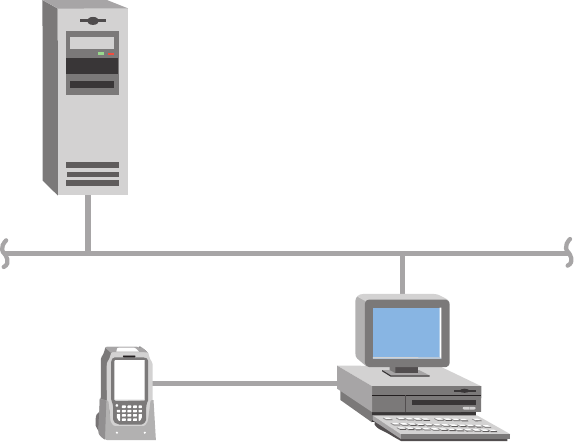
Chapter 3 — Adding the CN2 to the Network
46 CN2 Handheld Computer User’s Manual
Configuring the CN2 For Your Network
The CN2 is a versatile handheld computer that you can easily
add to your wired or wireless data collection network. You can
connect your CN2 to your network using:
• USB communications.
• 802.11b/g radio communications.
Configuring USB Communications
You can place the CN2 in the modem dock (P/N 075499) or
the communications dock (P/N 225-696-001) to transfer data
to, and receive data from, another device using USB
communications. The USB cable, communications dock, and
modem dock are sold separately. For more information on
accessories and how to order them, see page 115.
PC
Ethernet
USB cable
CN2 in
communications
dock
Host
CN2 Using USB Communications

Chapter 3 — Adding the CN2 to the Network
CN2 Handheld Computer User’s Manual 47
To use USB communications with your CN2
1 Connect the communications dock to the USB port of the
other device using an appropriate USB cable.
2 Make sure that your USB device is configured for USB
communications.
3 Insert the CN2 into the communications dock.
4 Turn on the CN2.
For more information about the communications dock, see the
instructions that ship with the communications dock.
Configuring 802.11b/g Radio Communications
Make sure all components with antennas are at least 30 cm
(1 ft) apart when power is applied. Failure to comply could
result in equipment damage.
Attention: Assurez-vous que la distance entre tous les
éléments avec antennes soit d’au moins 30 centimètres (un
pied) avant de faire la connexion avec l’alimentation
électrique, faute de quoi vous risquez d’endommager votre
installation.
Vorsicht: Sicherstellen, dass alle Komponenten mit
Antennen mindestens 30 cm (1 ft) voneinander entfernt
sind, wenn die Stromversorgung eingeschaltet wird.
Andernfalls könnte es zu Geräteschäden kommen.
The wireless CN2 has an internal 802.11b/g radio to transfer
data using wireless communications. This section of the manual
assumes that you have already set up your wireless
communications network including your access points. If you
are using a UDP Plus network, you also need to have your
Intermec Application Server communicating with a host
computer.
Your CN2 supports these network protocols:
• TCP/IP
• UDP Plus
The next sections explain the parameters you need to configure
for the CN2 to work in your wireless network.
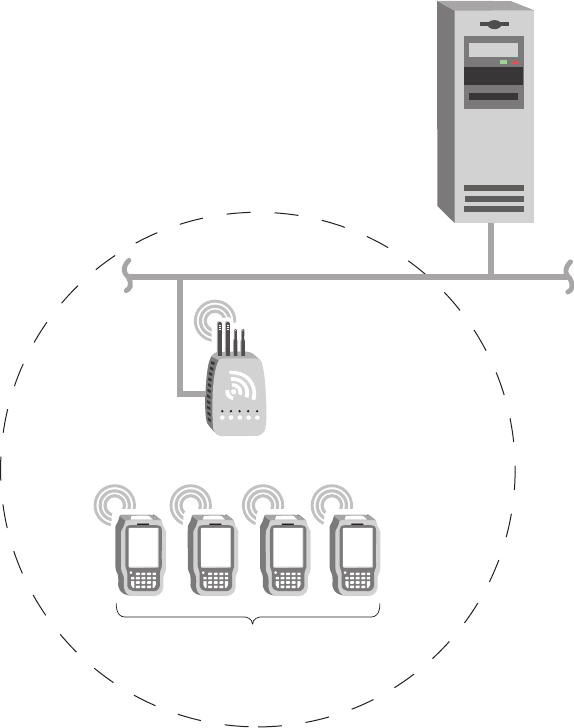
Chapter 3 — Adding the CN2 to the Network
48 CN2 Handheld Computer User’s Manual
Configuring the Network Parameters for a TCP/IP Network
In a TCP/IP network, the CN2 communicates with a host
computer directly using TCP/IP. The access point acts as a
bridge to allow communications between the wired network and
the wireless network.
Ethernet
TCP/IP
Direct Connect
CN2s
Access point
Host
CN2s in a TCP/IP Direct Connect Network
Chapter 3 — Adding the CN2 to the Network
CN2 Handheld Computer User’s Manual 49
To use wireless communications in a TCP/IP network
1 Configure these network parameters on each CN2 in the
network:
• Infrastructure mode (set to Infrastructure by default)
• Network name (SSID)
• Host IP address
• IP settings (if not using DHCP)
2 Configure security. For help, see “Configuring Network
Security” on page 51.
The easiest way to configure the network parameters on the
CN2 is to use Intermec Settings. For help, see “Configuring the
CN2 Locally With Intermec Settings” on page 36.
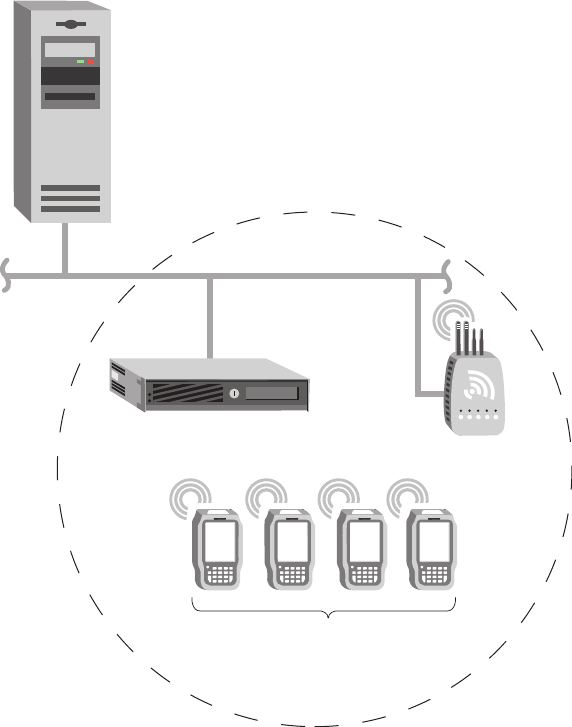
Chapter 3 — Adding the CN2 to the Network
50 CN2 Handheld Computer User’s Manual
Configuring the Network Parameters for a UDP Plus Network
In a UDP Plus network, the CN2 communicates with a host
computer through the Intermec Application Server.
Ethernet
UDP Plus
Access point
Host
Intermec Application Server
CN2s
CN2s in a UDP Plus Network
Chapter 3 — Adding the CN2 to the Network
CN2 Handheld Computer User’s Manual 51
The Intermec Application Server translates UDP Plus packets on
the wireless network into TCP/IP packets on the wired network
and vice versa. The access point acts as a bridge to allow
communications between the wired network and the wireless
network.
To use wireless communications in a UDP Plus network
1 Configure these network parameters on each CN2 in the
network:
• Network name (SSID)
• Controller IP address
• IP settings (if not using DHCP)
• Controller port (set to 5555)
2 Configure the security. For help, see “Configuring Network
Security” on page 51.
The easiest way to configure the network parameters on the
CN2 is to use Intermec Settings. For help, see “Configuring the
CN2 Locally With Intermec Settings” on page 36.
Configuring Network Security
The CN2 provides three types of security for your wireless
network:
• Wi-Fi Protected Access (WPA)
• 802.1x
• WEP
This section explains how to configure security on your wireless
CN2. If you choose not to use security, see “Disabling Security”
on page 68. Intermec always recommends that you implement
security.
You must use either Funk Security or Microsoft Security
software to implement your security solution. For details, see the
next section, “Choosing Between Funk Security and Microsoft
Security Software.”

Chapter 3 — Adding the CN2 to the Network
52 CN2 Handheld Computer User’s Manual
Note: If you are using 802.1x security, this section assumes that
your authentication server and authenticators are properly
configured. For more information on the different types of
security, see the MobileLAN™ secure 802.1x Security Solution
Installation Guide (P/N 073134) available at
www.intermec.com.
Choosing Between Funk Security and Microsoft Security Software
Before you can implement a security solution on the CN2, you
need to choose between Funk Security and Microsoft Security
software.
Both offer the same features, except Funk Security (the default)
also offers these features:
• CCX v1.0 compliance
• Ability to use LEAP and TTLS authentication on your CN2
• Up to four profiles, which are sets of configuration settings
If you choose Funk Security (the default), you are assigned
Profile 1, which specifies a Network Name of INTERMEC and
contains no security settings. You should consider configuring
security in Profile 1 or selecting another profile. For help, see the
next section, “Selecting and Defining Profiles for Funk
Security.”
If you choose Microsoft Security, you need to select Microsoft
Security. For help, see “Choosing Microsoft Security Software”
on page 53.
Note: Your choice does not depend on your authentication
server. For example, you can choose Funk Security if you use
Microsoft Active Directory® to issue certificates.
Selecting and Defining Profiles for Funk Security
You can define up to four profiles for your Funk security.
Different profiles let your CN2 communicate in different
networks without having to change all of your security settings.
For example, you may want to set up one profile for the
manufacturing floor and one for the warehouse.
By default, the active profile is Profile 1.

Chapter 3 — Adding the CN2 to the Network
CN2 Handheld Computer User’s Manual 53
To select a profile for Funk security
1 Tap the Start icon. The Start menu appears.
2 Tap Intermec Settings. The Intermec Settings application
appears.
3 Tap Communications > 802.11 Radio > Security Settings
> Funk Security.
4 (Optional) Give your profiles meaningful names:
a Select Profile 1, Profile2, Profile 3, or Profile 4. The
profile expands.
b Select Profile Label and a text box appears.
c Select the text in the box and use the input panel to type in
your meaningful name.
d Tap the Save icon at the top of the screen.
5 (Optional) Configure the security settings for each profile you
need.
6 (Optional) Select one profile as the active profile by tapping
Active Profile and choosing the profile name from the drop-
down menu.
7 Tap the Save icon at the top of the screen to save your
settings.
8 Tap the X at the top of the screen to exit Intermec Settings.
Choosing Microsoft Security Software
The default security choice is Funk Security. If you want to use
Microsoft Security, you need to choose it as your security choice.
To choose to Microsoft Security
1 Tap Start > Intermec Settings > Communications > 802.11
Radio > Security Settings.
2 For Security Choice, choose Microsoft Security.
3 Tap anywhere outside the Security Choice box, and an alert
box appears telling you that you must save your settings and
warm boot the CN2 for your new security choice to take
effect. Tap OK to close the alert box.

Chapter 3 — Adding the CN2 to the Network
54 CN2 Handheld Computer User’s Manual
4 Tap the Save icon at the top of the screen to save your
settings.
5 Tap the X at the top of the screen to exit Intermec Settings.
6 Warm boot the CN2. For help, see “Warm Booting the
CN2” on page 104.
Note: You must warm boot the CN2 after you change your
security choice.
Using WPA Security
Wi-Fi Protected Access (WPA) is a strongly enhanced,
interoperable Wi-Fi security that addresses many of the
vulnerabilities of Wired Equivalent Privacy (WEP). Instead
of WEP, WPA uses Temporal Key Integrity Protocol (TKIP)
for its data encryption method.
Currently, WPA satisfies some of the requirements in the IEEE
802.11i draft standard. When the standard is finalized, WPA
will maintain forward compatibility.
WPA runs in 802.1x (Enterprise) mode or PSK (Pre-Shared
Key) mode:
• In Enterprise mode, WPA provides user authentication using
802.1x and the Extensible Authentication Protocol (EAP).
That is, an authentication server (such as a RADIUS server)
must authenticate each device before the device can
communicate with the wireless network.
• In PSK mode, WPA provides user authentication using a
shared key between the authenticator and the CN2. WPA-
PSK is a good solution for small offices or home offices that
do not want to use an authentication server.
To use WPA security, you need:
• an authentication server (Enterprise mode only).
Note: You can also use a MobileLAN access WA2X product
as an authentication server. For help, see the MobileLANaccess
WA2X System Manual (P/N 073915).

Chapter 3 — Adding the CN2 to the Network
CN2 Handheld Computer User’s Manual 55
• user and root certificates (if you plan to use TLS for
authentication).
• an access point with an 802.11b/g radio that supports WPA.
• a CN2 with the 802.11b/g radio and the 802.1x/WPA
security option.
Configuring WPA Security With Funk Security
Use these procedures to set WPA-802.1x and WPA-PSK
security on your CN2 with Funk security.
To enable WPA-802.1x security on your CN2 with Funk security
1 Make sure you have configured the communications and
radio parameters on your CN2.
2 Make sure you have selected Funk as your security choice, as
described in “Choosing Between Funk Security and Microsoft
Security Software” on page 52.
3 If you plan to use TLS for authentication, load a user and
root certificate on your CN2. For help, see “Loading
Certificates” on page 65.
4 Open Intermec Settings.
5 Tap Communications > 802.11 Radio > Security Settings
> Funk Security > Profile.
6 For Association, choose WPA and tap the Save icon in the
upper right corner of the screen. Encryption is set to TKIP
by default.
7 For Authentication, choose TTLS, PEAP, or TLS and tap
Save.
If you choose TTLS or PEAP:
a Select User name, select the text in the text box, use the
input panel to type your user name, and tap Save.
b For Password prompt, make sure that Enter password
now is selected.
Note: You can use Prompt for password to troubleshoot
your connection to the network if you have problems.

Chapter 3 — Adding the CN2 to the Network
56 CN2 Handheld Computer User’s Manual
c Select User Password, select the text in the text box, use
the input panel to type your user password, and tap Save.
d For Validate Server Certificate, choose Enabled and tap
Save.
Note: You must have the date on the CN2 set correctly
when you enable Validate Server Certificate.
If you choose TLS:
a For Validate Server Certificate, choose Enabled and tap
Save.
b You must enter a User Name and Subject Name. You can
also enter a Server Common Name if you want to increase
your level of security.
8 Exit Intermec Settings.
To enable WPA-PSK security on your CN2 with Funk security
1 Make sure you have configured the communications and
radio parameters on your CN2.
2 Make sure you have selected Funk as your security choice, as
described in “Choosing Between Funk Security and Microsoft
Security Software” on page 52.
3 Open Intermec Settings.
4 Tap Communications > 802.11 Radio > Security Settings
> Funk Security > Profile.
5 For Association, choose WPA and tap Save.
6 For Authentication, choose None and tap Save.
7 For Pre-Shared Key, enter the pre-shared key or the
passphrase.
The pre-shared key must be a value of 32 hex pairs preceded
by 0x for a total of 66 characters. The value must match the
key value on the access point. The passphrase must be from 8
to 63 characters. After you enter a passphrase, the CN2
internally converts it to a pre-shared key.
This value must match the passphrase on the authenticator.
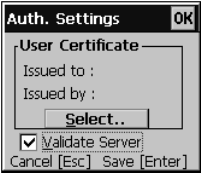
Chapter 3 — Adding the CN2 to the Network
CN2 Handheld Computer User’s Manual 57
8 Exit Intermec Settings.
Configuring WPA Security With Microsoft Security
Use these procedures to set WPA-802.1x and WPA-PSK
security on your CN2 with Microsoft security. These procedures
assume that you have selected Microsoft Security software as
your security choice, as described in “Choosing Between Funk
Security and Microsoft Security Software” on page 52.
To enable WPA-802.1x security on your CN2 with Microsoft security
1 Make sure you have configured the communications and
radio parameters on your CN2.
2 If you plan to use TLS for authentication, load a user and
root certificate on your CN2. For help, see “Loading
Certificates” on page 65.
3 Open Intermec Settings.
4 Tap Communications > 802.11 Radio > Security Settings
> Microsoft Security.
5 For Infrastructure Mode, choose Infrastructure.
6 For Network Authentication, choose WPA and tap the Save
icon in the upper right corner of the screen. Data Encryption
is set to TKIP by default.
7 For 802.1x Authentication, choose either TLS or PEAP.
If you choose TLS:
a Tap Properties and tap Run App. The Authentication
Settings box appears.
b From the Authentication Settings box, tap Select.
c Tap your certificate from the list and tap Enter.
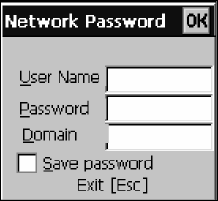
Chapter 3 — Adding the CN2 to the Network
58 CN2 Handheld Computer User’s Manual
If you choose PEAP:
a Tap Properties and tap Run App. The Authentication
Settings box appears.
b Tap the Validate Server check box.
c Tap Enter. After the radio starts to authenticate, the
Network Password dialog box appears:
d Enter a User Name and Password and tap the Save
Password check box.
e (Optional) In the Domain field, enter the Active Directory
domain associated with the user account.
f Press Enter.
8 Exit Intermec Settings.
To enable WPA-PSK security on your CN2 With Microsoft security
1 Make sure you have configured the communications and
radio parameters on your CN2.
2 If you plan to use TLS for authentication, load a user and
root certificate on your CN2. For help, see “Loading
Certificates” on page 65.
3 Open Intermec Settings.
4 Choose Communications > 802.11 Radio > Security
Settings > Microsoft Security.
5 For Infrastructure Mode, choose Infrastructure.
6 For Network Authentication, choose WPA-PSK and tap
the Save icon in the upper right corner of the screen. Data
Encryption is set to TKIP by default.

Chapter 3 — Adding the CN2 to the Network
CN2 Handheld Computer User’s Manual 59
7 For Pre-Shared Key, enter the pre-shared key or the
passphrase.
The pre-shared key must be a value of 32 hex pairs preceded
by 0x for a total of 66 characters. The value must match the
key value on the authenticator. The passphrase must be from
8 to 63 characters. After you enter a passphrase, the CN2
internally converts it to a pre-shared key.
This value must match the passphrase on the authenticator.
8 Exit Intermec Settings.
Using 802.1x Security
802.1x security provides centralized user authentication using an
authentication server, authenticators (access points), and
supplicants. These components communicate using an EAP
authentication type, such as TLS (Transport Layer Security) or
PEAP (Protected Extensible Authentication Protocol). 802.1x
security provides data encryption using dynamic WEP key
management.
To use 802.1x security, you need:
• an authentication server.
Note: You can also use a MobileLAN access WA2X product
as an authentication server. For help, see the MobileLANaccess
WA2X System Manual (P/N 073915).
• an access point with an 802.11b/g radio.
• a CN2 with an 802.11b/g radio and the 802.1x/WPA
security option.
• user and root certificates (if you plan to use TLS for
authentication).
These procedures assume that you have already selected either
Microsoft Security or Funk Security software as your security
choice, as described in “Choosing Between Funk Security and
Microsoft Security Software” on page 52.

Chapter 3 — Adding the CN2 to the Network
60 CN2 Handheld Computer User’s Manual
Configuring 802.1x Security With Funk Security
1 Make sure you have configured the communications and
radio parameters on your CN2.
2 Make sure you have selected Funk as your security choice.
3 If you plan to use TLS for authentication, load a user and
root certificate on your CN2. For help, see “Loading
Certificates” on page 65.
4 Open Intermec Settings.
5 Choose Communications > 802.11 Radio > Security
Settings > Funk Security > Profile.
6 For Association, tap Open and tap Save.
7 For Encryption, tap WEP and tap Save.
8 For Authentication, tap TTLS, PEAP, or TLS and tap Save.
If you choose TTLS or PEAP:
a Select User name, type your user name, and then tap
Save.
b Select Password prompt, choose Enter password now,
and then tap Save.
Note: You can use Prompt for password to troubleshoot
your connection to the network if you have problems.
c Select User Password, type a user password, and then tap
Save.
d For Validate Server Certificate, choose Enabled and tap
Save.
If you choose TLS:
a For Validate Server Certificate, choose Enabled and tap
Save.
b You can also enter a User Name, Subject Name and
Server Common Name if you want to increase your level
of security.
9 Exit Intermec Settings.
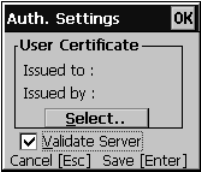
Chapter 3 — Adding the CN2 to the Network
CN2 Handheld Computer User’s Manual 61
Configuring 802.1x Security With Microsoft Security
1 Make sure you have configured the communications and
radio parameters on your CN2.
2 If you plan to use TLS for authentication, load a user and
root certificate on your CN2. For help, see “Loading
Certificates” on page 65.
3 Open Intermec Settings.
4 Choose Communications > 802.11 Radio > Security
Settings > Microsoft Security.
5 For Infrastructure Mode, choose Infrastructure.
6 For Network Authentication, choose Open.
7 For Data Encryption, choose WEP.
8 For 802.1X Authentication, choose TLS or PEAP, and tap
Save.
If you choose TLS:
a Select Properties and tap Run App. The Authentication
Settings box appears.
b From the Authentication Settings box, tap Select.
c Select your certificate from the list and tap Save.
If you choose PEAP:
a Select Properties and tap Run App. The Authentication
Settings box appears.
b Select the Validate Server check box.
c Press Enter. Once the radio starts to authenticate, the
Network Password dialog box appears.
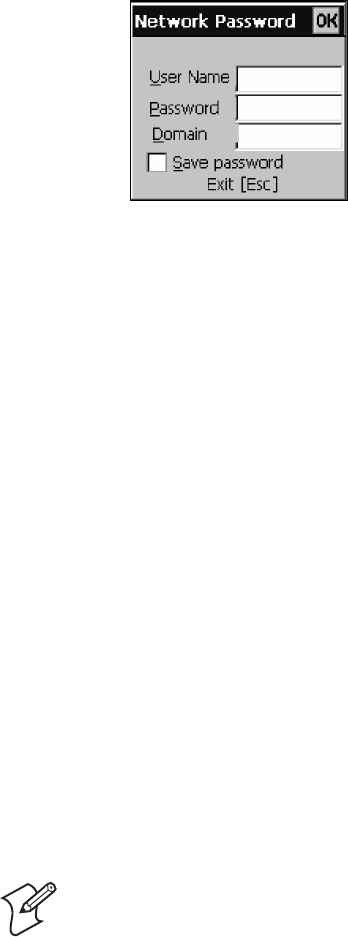
Chapter 3 — Adding the CN2 to the Network
62 CN2 Handheld Computer User’s Manual
d Enter a User Name and Password and select the Save
Password check box.
e (Optional) In the Domain field, enter the domain.
f Press Enter.
9 For Network Key Setting, choose Automatic.
10 Exit Intermec Settings.
Using LEAP Security
Lightweight Extensible Authentication Protocol (LEAP), also
known as Cisco-Wireless EAP, provides username/password-
based authentication between a wireless client and a RADIUS
server. In the 802.1x framework, traffic cannot pass through an
Ethernet hub or wireless network access point until it
successfully authenticates itself.
The station must identify itself and prove that it is an authorized
user before it is actually allowed to use the LAN. LEAP also
delivers a session key to the authenticated station, so that future
frames can be encrypted with a key that is different than keys
used by others’ sessions.
To use LEAP security, you need:
• a RADIUS server.
• a Cisco access point with an 802.11b/g radio.
Note: LEAP security is not supported if you chose Microsoft
Security software, as described in “Choosing Between Funk
Security and Microsoft Security Software” on page 52.

Chapter 3 — Adding the CN2 to the Network
CN2 Handheld Computer User’s Manual 63
To enable LEAP security on your CN2
1 Make sure you have configured the communications and
radio parameters on your CN2.
2 Make sure you have selected Funk as your security choice, as
described in “Choosing Between Funk Security and Microsoft
Security Software” on page 52.
3 Open Intermec Settings.
4 Tap Communications > 802.11 Radio > Security Settings
> Funk Security > Profile.
5 For Authentication, select LEAP and then tap Save.
6 For Association, select Open or Network EAP and then tap
Save.
7 For Encryption, select WEP, and then tap Save.
8 Select User name, type your user name, and then tap Save.
9 Select Password prompt, choose Enter password now, and
then tap Save.
Note: You can use Prompt for password to troubleshoot
your connection to the network if you have problems.
10 Select User Password, type a user password, and then tap
Save.
11 Exit Intermec Settings.
Using Static WEP Security
The CN2 uses the Wired Equivalent Privacy (WEP) protocol to
add security to your wireless network based on the 802.11b
standard.
To use WEP security, you need:
• an access point with an 802.11b/g radio.
• a CN2 handheld computer with an 802.11b/g radio.
Configuring Static WEP Security With Funk Security
1 Make sure you have configured the communications and
radio parameters on your CN2.
Chapter 3 — Adding the CN2 to the Network
64 CN2 Handheld Computer User’s Manual
2 Make sure you have chose Funk Security software as your
security choice, as described in “Choosing Between Funk
Security and Microsoft Security Software” on page 52.
3 Open Intermec Settings.
4 Tap Communications > 802.11 Radio > Security Settings
> Funk Security > Profile.
5 For Association, choose Open, and then tap Save.
6 For Encryption, choose WEP and then tap Save.
7 For Authentication, choose None and then tap Save.
8 Select WEP Key and then define a value for each WEP key.
You can define up to four WEP keys.
Enter an ASCII key or a hex key that is either 5 bytes or 13
bytes long depending on the type of WEP encryption you are
using. Set a 5-byte value for 64-bit WEP or a 13-byte value
for 128-bit WEP. Hex values must be preceded by 0x and
contain 5 or 13 hex pairs.
9 Select Network Key Index, choose the WEP key you want to
use for transmitting data.
10 Exit Intermec Settings.
Configuring Static WEP Security With Microsoft Security
1 Make sure you have configured the communications and
radio parameters on your CN2.
2 Make sure you have selected Microsoft as your security
choice, as described in “Choosing Between Funk Security and
Microsoft Security Software” on page 52.
3 Open Intermec Settings.
4 Choose Communications > 802.11 Radio > Security
Settings > Microsoft Security.
5 For Network Authentication, choose Open.
6 For Data Encryption, choose WEP.
7 For Network Key Setting, choose Enter Key and Index.

Chapter 3 — Adding the CN2 to the Network
CN2 Handheld Computer User’s Manual 65
8 For Network Key Value, enter an ASCII key or a hex key
that is either 5 bytes or 13 bytes long depending on the type
of WEP encryption you are using.
Set a 5-byte value for 64-bit WEP or a 13-byte value for 128-
bit WEP. Hex values must be preceded by 0x and contain 5
or 13 hex pairs.
9 For Network Key Index, select the key you want to use for
data transmission.
10 Exit Intermec Settings.
Loading Certificates
If you choose to use transport layer security (TLS) with WPA or
802.1x security, you need to have a unique client certificate on
the CN2 and a trusted root certificate authority (CA) certificate.
You can use a third-party CA to issue unique client certificates
and a root certificate.
If you are using Active Directory® to issue certificates, you can
use the Enroll Certificates application to load the certificates. If
you are using a third-party CA, you can use the Import Root or
User Certificates programs to load the certificates.
Note: Do not cold boot the CN2. Cold booting the computer
resets the date and time. If you cold boot the CN2, you must
immediately update the date and time or the installed certificates
may be deemed invalid. For help setting the date and time, see
Step 4 on page 106.
To load certificates on the CN2 if you are using Active Directory
1 Configure the network and radio settings for the CN2 to
communicate with your certificate authority or establish an
ActiveSync connection with the CA.
2 Tap Start > Intermec Settings > Communications > 802.11
Radio > Security Settings > Certificates.
3 Select Enroll Certificates and tap Run App.
4 From the Run Application box, tap Yes. The Enroll
Certificates dialog box appears.
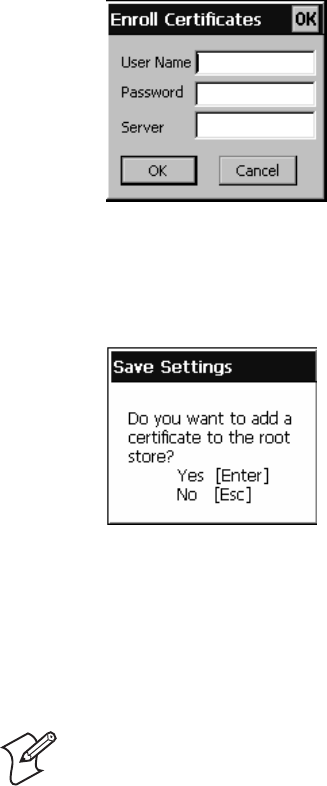
Chapter 3 — Adding the CN2 to the Network
66 CN2 Handheld Computer User’s Manual
5 Enter the User Name, Password, and Server (IP address) to
log in to the CA server.
6 Tap OK. A dialog box appears asking if you want to load the
root certificate.
7 Press Enter for yes. The Enrollment Tool message box
appears telling you that the user certificate has been added.
8 Press Enter to close the Enrollment Tool message box.
9 Configure your CN2 for WPA or 802.1x security.
To load certificates on the CN2 if you are using a third-party CA
Note: You need to create the \temp\root and \temp\user folders
on your CN2 before you can copy the certificate files to your
handheld computer.
1 Copy your .cer file to the \temp\root folder on the CN2.
2 Copy your .der and .pvk files to the \temp\user folder on the
CN2.
3 Tap Start > Intermec Settings > Communications > 802.11
Radio > Security Settings > Certificates.

Chapter 3 — Adding the CN2 to the Network
CN2 Handheld Computer User’s Manual 67
4 Select Import Root Certificates and tap Run App to load
the .cer file. A dialog box appears asking if you want to add
the certificate to the root store.
5 Tap Enter to add the certificate. A message box appears
telling you that the root certificate has been imported.
6 Tap OK to close the Success message box.
7 Select Import User Certificate to load the .der and .pvk files.
A message box appears telling you that the certificate has been
imported.
8 Tap OK to close the Success message box.
9 Configure your CN2 for WPA or 802.1x security.

Chapter 3 — Adding the CN2 to the Network
68 CN2 Handheld Computer User’s Manual
Disabling Security
If you choose not to use security with your wireless network, you
can disable it on the CN2. Intermec recommends that you
always set security in your network.
To disable security
1 Open Intermec Settings.
2 Tap Communications > 802.11 Radio > Security Settings
> Microsoft Security.
3 For Network Authentication, choose Open.
4 For Data Encryption, choose Disabled.
5 Tap Save.
6 Exit Intermec Settings.
Viewing Wireless Network Information
You can view wireless network information, such as current
network parameters and network parameters and a list of
available wireless networks.
This feature is available if you have Funk Security or Microsoft
Security configured as your security choice, as described in
“Choosing Between Funk Security and Microsoft Security
Software” on page 52.
To view wireless network information
1 Configure and add your wireless CN2 to your network.
2 Double-tap the Network Connection icon ( or ) in
the taskbar. The SWLD26C1 configuration screen appears.
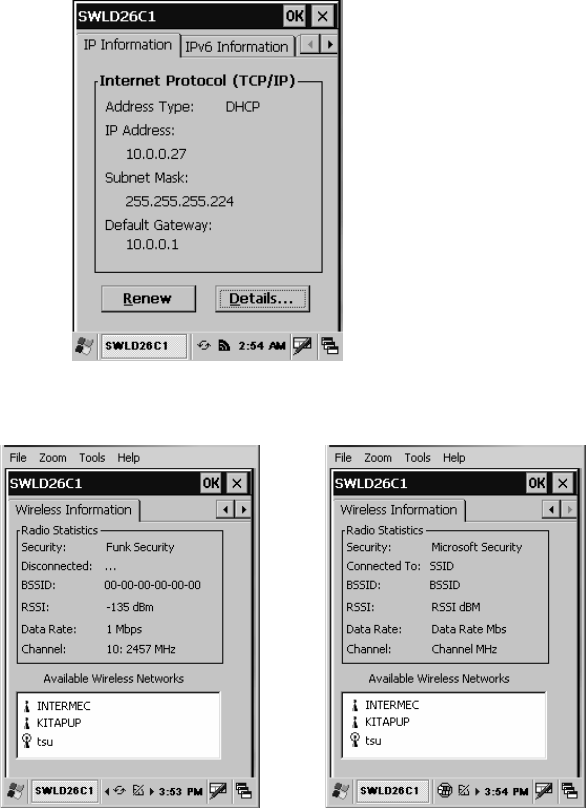
Chapter 3 — Adding the CN2 to the Network
CN2 Handheld Computer User’s Manual 69
3 Tap the right arrow button ( R ) twice and then tap the
Wireless Information tab to bring the tab forward.
Wireless Network Information: This tab shows wireless network information for
the CN2, including your security choice: Funk Security (the default) or Microsoft
Security. This tab lets you view wireless network parameters and a list of available
wireless networks. You cannot set parameters or select a network on this tab.
4 Tap OK to close the SWLD26C1 configuration screen.
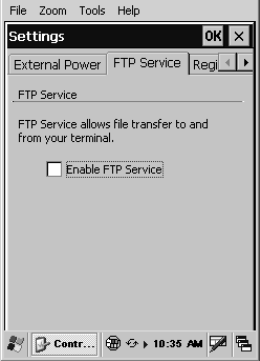
Chapter 3 — Adding the CN2 to the Network
70 CN2 Handheld Computer User’s Manual
Allowing FTP File Transfers To and From the CN2
If you want to use FTP (File Transfer Protocol) to transfer files
to or from your CN2, you need to enable the FTP Service
parameter through the Control Panel.
To allow FTP file transfers
1 Go to Start > Settings > Control Panel.
2 Double-tap the Utilities icon. The Settings screen appears.
3 Tap the FTP Service tab to bring the tab forward.
4 Tap the Enable FTP Service check box.
5 Tap OK to save your changes and exit the Settings screen.
6 Tap X to exit the Control Panel. The change takes effect
immediately. You do not need to warm boot the CN2.
Chapter 3 — Adding the CN2 to the Network
CN2 Handheld Computer User’s Manual 71
Using the Modem Dock for Internet Access and E-mail
If you have purchased the optional CN2 Modem Dock
(P/N 075499), you can configure the CN2 to use the modem
dock to connect to the Internet and to access e-mail.
If your Internet Service Provider (ISP) is providing your e-mail
service, follow the steps in the next section, “Connecting to the
Internet Through the Modem Dock,” before you follow the
steps in “Setting Up an E-mail Account Through the Modem
Dock” on page 78.
For details about installing and using the modem dock, see the
CN2 Modem Dock Quick Start Guide (P/N 075481) which ships
with the modem dock.
Connecting to the Internet Through the Modem Dock
You can connect to the Internet through the modem dock.
To configure a connection to your Internet service provider
1 Install the modem dock, as described in the CN2 Modem
Dock Quick Start Guide.
2 Contact your ISP and obtain the following information:
• ISP dial-up access phone number
• User name
• Password
3 Tap Start > Settings > Network and Dial-up Connections.
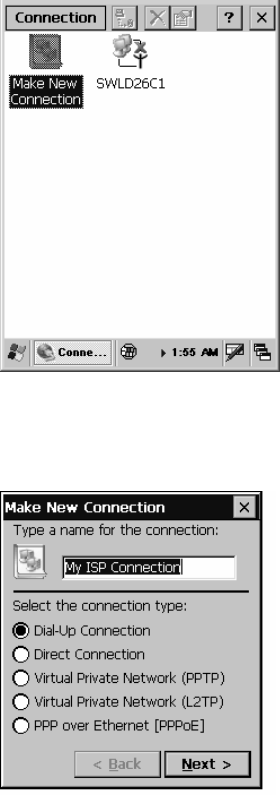
Chapter 3 — Adding the CN2 to the Network
72 CN2 Handheld Computer User’s Manual
4 Double-tap Make New Connection.
5 In the Type a name for the connection field, enter a name
for the connection, such as My ISP Connection.
6 From the Select the connection type list, select Dial-Up
Connection from the list of connection types.
7 Tap Next. The Modem screen appears.
8 From the Select a modem drop-down menu, choose Hayes
Compatible on COM1.
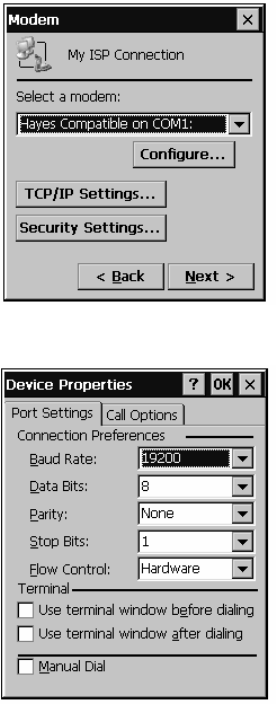
Chapter 3 — Adding the CN2 to the Network
CN2 Handheld Computer User’s Manual 73
9 Tap Configure. The Device Properties screen appears.
Connection Preferences: The connection preferences (such as Baud
Rate) specify how the CN2 communicates with the modem dock.
10 Set the Baud Rate to 115200 bps.
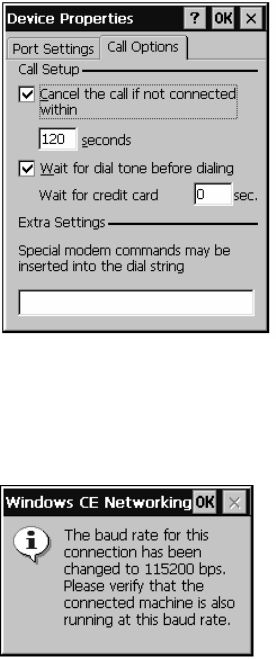
Chapter 3 — Adding the CN2 to the Network
74 CN2 Handheld Computer User’s Manual
11 (Optional) Tap the Call Options tab and make changes if
necessary.
12 Tap OK at the top of the screen to return to the Modem
screen.
13 If you changed the baud rate in Step 10, a message box
appears. Tap OK to close the message box.
14 Tap TCP/IP Settings only if your ISP does not use a
dynamically assigned IP address. When you are done making
selections, tap OK at the top of the screen to return to the
Modem screen.
15 Tap Security Settings to configure advanced security
settings, if necessary. The Security Settings screen appears.
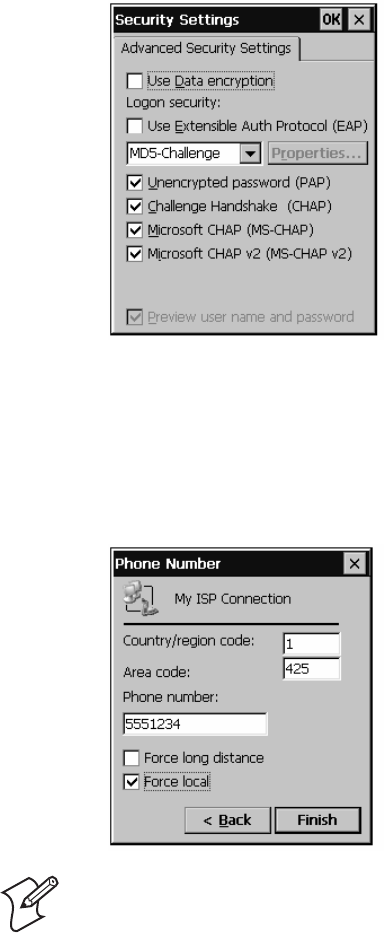
Chapter 3 — Adding the CN2 to the Network
CN2 Handheld Computer User’s Manual 75
When you are done making selections, tap OK at the top of
the screen to return to the Modem screen.
16 Tap Next on the Modem screen.
17 Fill in the Country/region code field, the Area code field,
and the Phone Number field with the information provided
by your ISP.
Note: When you connect to the Internet for the first time,
you can specify the exact numbers that the modem dials. For
help, see the next procedure, “To connect to the Internet for
the first time.”
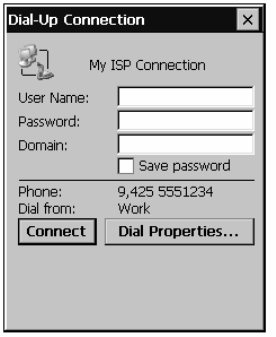
Chapter 3 — Adding the CN2 to the Network
76 CN2 Handheld Computer User’s Manual
18 Check Force long distance if the modem needs to dial the
country/region code, the area code, and the phone number.
Or check Force local if the modem needs to dial only the
phone number.
19 Tap Finish.
20 Perform the steps in the next procedure, “To connect to the
Internet for the first time.”
To connect to the Internet for the first time
1 Tap Start > Settings > Network and Dial-up Connections.
2 Double-tap the icon for the connection you just configured.
The Dial-Up Connection screen appears.
3 In the User Name field, enter the user name provided by
your ISP.
4 In the Password field, enter the password provided by your
ISP.
5 (Optional) Check the Save password check box if you do not
want to enter the password every time you connect.
6 Tap Dial Properties. The Dialing Properties screen appears.
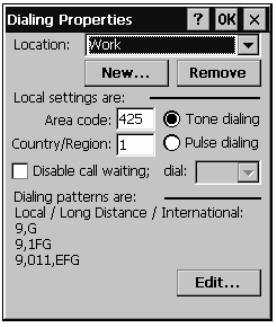
Chapter 3 — Adding the CN2 to the Network
CN2 Handheld Computer User’s Manual 77
7 By default, the CN2 assumes that you are dialing from work,
on a phone system that requires you to enter a 9 before
dialing. If you do not need to enter 9 before dialing, follow
these steps:
a Choose Home from the Location drop-down list. The
location setting has a dialing pattern that does not include
a 9 before dialing.
b Make sure the Area Code and Country/Region are
correct.
c (Optional) Tap Edit. The Edit Dialing Patterns screen
appears. Make sure the dialing pattern is appropriate and
tap OK to return to the Dialing Properties screen.
d Tap OK to return to the Dial-Up Connection screen.
8 Tap Connect. The modem dock connects to your ISP.
To connect to the Internet
1 Tap Start > Settings > Network and Dial-up Connections.
2 Double-tap the appropriate connection icon. The Dial-Up
Connection screen appears.
3 Your user name automatically appears in the User Name
field. Your password automatically appears in the Password
field if you checked the Save password check box.
4 Tap Connect. The modem dock connects to your ISP.

Chapter 3 — Adding the CN2 to the Network
78 CN2 Handheld Computer User’s Manual
5 Tap Hide to minimize the Connected to Name screen, where
Name is the name you configured for the connection.
To disconnect from the Internet
• Double-tap the Connectivity icon in the taskbar and then
tap Disconnect.
Setting Up an E-mail Account Through the Modem Dock
You can send and receive e-mail messages using the modem
dock and the Inbox application on your CN2. You need to set
up a connection to an e-mail server.
Note: The ISP or network must use a POP3 or IMAP4 e-mail
server and an SMTP gateway.
You can use multiple e-mail services to receive your messages.
For each e-mail service you intend to use, first set up and name
the e-mail service. If you use the same service to connect to
different mailboxes, set up and name each mailbox connection.
To configure your e-mail account
1 Contact your ISP and obtain the following information:
• POP3 or IMAP4 host name
• SMTP host name
• User name
• Password
2 Tap Start > Programs > Inbox to open the Inbox
application.
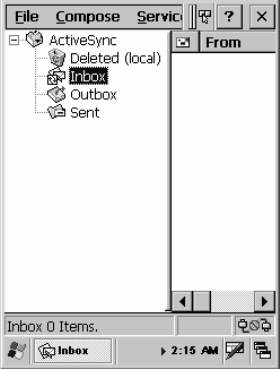
Chapter 3 — Adding the CN2 to the Network
CN2 Handheld Computer User’s Manual 79
3 Tap Service > Options. The Options screen appears.
4 Drag the screen to the left to view the right side of the screen.
5 Tap Add. The Service name screen appears.
6 Select the appropriate service type from the Service Type
drop-down menu, either POP3 or IMAP4.
7 (Optional) Enter a meaningful name in the Service Name
field. If you are setting up multiple e-mail services, each needs
a unique name.
8 Tap OK.
9 In the Connection drop-down list, choose the appropriate
connection. If you configured a connection to your ISP as
described in the previous section, that connection appears in
the list. You may want to choose that connection.
10 In the POP3 Host or IMAP4 Host field, enter the host
name provided by your ISP.
11 In the User ID field, enter the user name provided by your
ISP.
12 In the Password field, enter the password provided by your
ISP.
13 If you do not want to type the password each time you
connect, check the Save Password check box.

Chapter 3 — Adding the CN2 to the Network
80 CN2 Handheld Computer User’s Manual
14 Drag the screen to the left to view the right side of the screen.
15 If you want to be able to send e-mail from the CN2, in the
SMTP host for sending email field, you must enter the
SMTP host name provided by your ISP.
Note: The SMTP host name may be the same as your POP3
host name or IMAP4 host name.
16 (Optional) For help determining if you need to set the
optional parameters like Domain, tap to view the Inbox
online help.
17 Tap Next. The POP3 Mail General Preferences screen
appears.
18 Check or uncheck the check boxes to set your connection
preferences. For help, tap to view the Inbox online help.
19 Tap Next. The POP3 Mail Inbox Preferences screen appears.
20 By default, Inbox downloads only the message headers. If you
want to download the entire e-mail message, select Get full
copy of message.
21 Drag the screen to the left to view the right side of the screen.
22 (Optional) If you want to download attachments and meeting
requests, check the appropriate check boxes.
23 Tap Finish.
24 (Optional) Tap the Compose, Read, Delete, and Storage
tabs to further customize Inbox.
25 Tap OK to exit the Options screen.
To send and receive e-mail
• Tap Start > Programs > Inbox. For help, tap to view the
Inbox online help.

CN2 Handheld Computer User’s Manual 81
Developing and Installing
Applications
Use this chapter to understand how to develop and install
applications for the CN2. In this chapter, you will find these
sections:
• Developing Applications for the CN2
• Installing Applications on the CN2
• Setting Up Applications to Persist Through a Cold Boot
• Launching Your Application Automatically
4

Chapter 4 — Developing and Installing Applications
82 CN2 Handheld Computer User’s Manual
Developing Applications for the CN2
The CN2 runs applications programmed in Microsoft
Embedded Visual C++. The CN2 can also run applications
developed for the .NET Compact Framework using Microsoft
C# and Visual Basic .NET.
Use this section to understand the hardware and software you
need to perform these tasks:
• Developing a new application for the CN2
• Developing a web-based application for the CN2
Developing a New Application
To develop new applications to run on the CN2, use the
Resource Kits available as a download from the Intermec
Developer Library (IDL), which is located on the Intermec web
site at www.intermec.com.
Each Resource Kit includes C++ and .NET components
grouped by functionality:
• Data Collection Resource Kit
• Printing Resource Kit
• RFID Resource Kit
• Communications Resource Kit
• Bluetooth Resource Kit
• Device Resource Kit
• Mobile Gadgets Resource Kit
• Antares Migration Resource Kit (previously Intermec PSK)
Note: Not all Resource Kits (such as the Bluetooth Resource
Kit) can be used with the CN2.
The IDL also includes a Resource Kit for each operating system.
For the CN2, you need to download Resource Kit for the
Microsoft CE .NET Operating System.
Chapter 4 — Developing and Installing Applications
CN2 Handheld Computer User’s Manual 83
You need these hardware and software components to use the
Resource Kits:
• Pentium PC, 400 MHz or higher
• Windows 2000 (Service Pack 2 or later) or Windows XP
(Home, Professional, or Server)
• For native C++ development, Microsoft eMbedded Visual
C++ version 4.0 with eVC++ Service Pack 2
• For .NET Development and Compact Framework (C# and
VB.NET), Microsoft Visual Studio .NET 2003
• 128MB RAM (196MB recommended)
• 360MB hard drive space for minimum installation (720MB
for complete)
• CD-ROM drive compatible with multimedia PC
specification
• VGA or higher-resolution monitor (Super VGA
recommended)
• Microsoft Mouse or compatible pointing device
Developing a Web-Based Application
You can develop web-based data collection applications for use
on the CN2. For help, see any HTML source book.
The CN2 contains Internet Explorer (IE) 6.0 for Windows CE
for you to use. The Microsoft standard IE 6.0 is available from
the desktop and provides all of the common elements you expect
to find.
To open Microsoft Internet Explorer
• Double-tap Internet Explorer from the desktop. The
Internet Explorer default window appears.

Chapter 4 — Developing and Installing Applications
84 CN2 Handheld Computer User’s Manual
Installing Applications on the CN2
There are three approaches to installing applications on the
CN2:
• You can package your application as a cabinet (.cab) file.
Intermec recommends this approach.
• If you have a simple application, you may only need to deliver
the .exe file.
• You can copy a directory structure that contains the
application, supporting files, DLLs, images, and data files.
Intermec makes these recommendations:
• You should use .cab files to install your applications. The
CN2 uses standard Windows CE .cab files and will install
third-party .cab files. After the CN2 executes a .cab file, it
deletes the .cab file.
• You should store your applications in a folder specific to your
application under the \PROGRAM FILES folder. These
applications are deleted during a cold boot.
• You should make sure that .cab files are saved after being
executed and that applications are reinstalled during a cold
boot by following the instructions in “Setting Up
Applications to Persist Through a Cold Boot” on page 90.
• You should store your application data in one of these folders:
Where to Store Your Application Data Files
Folder Description Recommendation
SDMMC Disk The SDMMC Disk folder shows
the contents of the SD card.
These files are not deleted during
by a cold boot.
If your CN2 contains an optional SD
card, Intermec recommends that you
place application data files in this
folder.
DiskOnChip The DiskOnChip folder is an area
of storage that is part of the CN2
flash memory. These files are not
deleted during a cold boot.
If your CN2 does not contain an
optional SD card, Intermec
recommends that you place
application data files in this folder.

Chapter 4 — Developing and Installing Applications
CN2 Handheld Computer User’s Manual 85
The following sections describe the three methods of installing
files and applications on the CN2:
• To use ActiveSync, see the next section, “Installing
Applications Using ActiveSync.”
• To use the SD card, see “Installing Applications Using the
Optional SD Card” on page 89.
• To use Wavelink Avalanche, see “Installing Applications
Using Wavelink Avalanche” on page 89.
Installing Applications Using ActiveSync
You can use ActiveSync to establish a connection between your
PC and the CN2. ActiveSync allows you to transfer files,
synchronize files, perform remote debugging, and other device
management activities.
Note: ActiveSync is a free application available from the
Microsoft web site.
To establish a partnership between your PC and the CN2, you
need these items:
• USB interface cable (P/N 321-576-002)
• CN2 communications dock (P/N 225-696-001)
• ActiveSync version 3.7.1 or later
Installing ActiveSync and Establishing a Partnership
You can use a USB cable to establish your initial partnership
between the CN2 and your PC.
To install ActiveSync and establish a partnership
1 Download ActiveSync from the Microsoft web site and follow
the onscreen instructions for installing it on your PC. When
the installation process is complete, the Get Connected dialog
box appears.
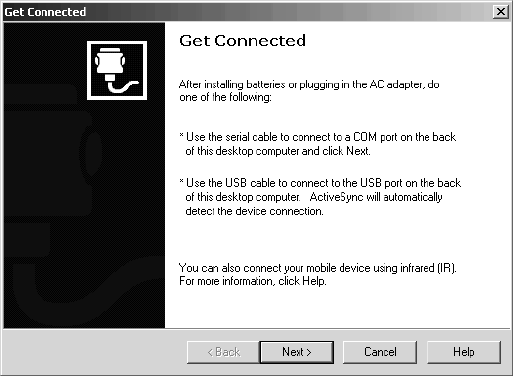
Chapter 4 — Developing and Installing Applications
86 CN2 Handheld Computer User’s Manual
2 Connect the CN2 to your PC with the CN2 communications
dock and a USB cable.
3 Click Next in the Get Connected dialog box. ActiveSync
detects a device on the USB port and prompts you to set up a
new partnership.
4 In the Set Up a Partnership dialog box, click Next.
5 In the Select Number of Partnerships dialog box, select Yes, I
want to synchronize with only this computer, and then
click Next.
6 In the Select Synchronization Settings dialog box, check the
items you want to synchronize and click Next.
7 In the Setup Complete dialog box, click Finish.
When the partnership has been established, the following screen
appears on your PC showing the device name of your CN2 and
the Connected status.
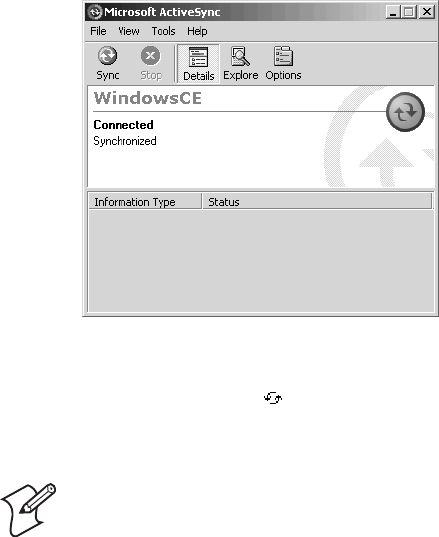
Chapter 4 — Developing and Installing Applications
CN2 Handheld Computer User’s Manual 87
The Microsoft ActiveSync Screen
An ActiveSync icon ( ) also appears on the CN2 status bar
indicating that it has established an ActiveSync partnership with
your PC.
Note: If ActiveSync does not establish a partnership on the
first try, the Get Connected dialog box appears on your PC with
the message “Your device was not detected.” Make sure all of
your cables are securely connected and click Next on the Get
Connected dialog box until your device is detected. You may
need to remove the CN2 from the communications dock, and
then insert it back into the communications dock to establish a
partnership.
After the partnership is established, ActiveSync initiates all
future connections. To connect to your PC using ActiveSync in
the future, simply place a CN2 in the communications dock and
turn on the CN2.
Using ActiveSync to Copy Files and Install Applications
You can use ActiveSync to copy files to the CN2 and to install
applications. Use the following procedures to learn how to copy
files and install applications on the CN2 using ActiveSync.
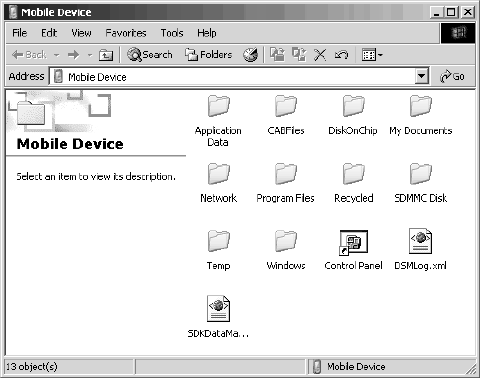
Chapter 4 — Developing and Installing Applications
88 CN2 Handheld Computer User’s Manual
To install an application on the CN2 using ActiveSync
1 Connect the CN2 to your PC using ActiveSync. For help, see
the previous section, “Installing ActiveSync and Establishing a
Partnership.”
2 On the Microsoft ActiveSync screen, click Explore. Windows
Explorer opens the Mobile Device window of your CN2.
3 In Windows Explorer on your PC, browse to the file that you
want to copy to your CN2.
4 Right-click the file and click Copy.
5 Place the cursor in the SDMMC Disk or DiskOnChip folder
of your CN2, right-click, and click Paste.
6 The file is copied to the CN2 and you can see it using My
Computer on the CN2.
7 Navigate to your application file and run it.
After your application is installed, you can run it from the
Program files folder from My Computer.

Chapter 4 — Developing and Installing Applications
CN2 Handheld Computer User’s Manual 89
Installing Applications Using the Optional SD Card
Using your SD card is the best method for you to install
applications. For help inserting and removing the SD card, see
“Increasing File Storage With the Optional SD Card” on
page 26.
To install applications using the SD card
1 If you are using an SD card reader, remove the SD card from
the CN2 and place it in the reader.
2 Copy your application file to the SD card.
If you are using ActiveSync or Wavelink Avalanche to copy
the files to the SD card, place the application in the SDMMC
Disk folder located in My Computer.
3 If you are using an SD card reader, insert the SD card back
into the CN2.
4 Navigate to the SDMMC Disk folder and run your
application.
After your application is installed, you can run it from the
Program files folder from My Computer.
Installing Applications Using Wavelink Avalanche
You can use the Wavelink Avalanche device management system
to install applications on all of your wireless CN2s.
The wireless CN2 ships with the Avalanche Enabler already
loaded on it. The Avalanche Enabler is configured to activate
automatically (typically on a warm boot).
Note: If you manually activate the Avalanche Enabler on the
CN2, you may be prompted for a password when you exit the
Avalanche Enabler. The default password is leave.
Each time the Avalanche Enabler is activated, the CN2 attempts
to connect to the Avalanche Agent. When the CN2 connects to
the Agent, the Agent determines whether an update is available
and immediately starts the software upgrade, file transfer, or
configuration update.
Chapter 4 — Developing and Installing Applications
90 CN2 Handheld Computer User’s Manual
To use Avalanche to remotely manage the CN2
1 Install software packages and updates for the CN2 using the
Avalanche Management Console. For help using the console,
see the online help.
2 Schedule the CN2 updates or manually initiate an update
using the Avalanche Management Console.
For more information on using Wavelink Avalanche, contact
your local Intermec representative or visit the Wavelink web site
at www.wavelink.com.
Setting Up Applications to Persist Through a Cold Boot
If you install your applications as recommended in a folder in
the \PROGRAM FILES folder, you have installed your
applications into the object store. These applications are deleted
during a cold boot.
To make sure your applications are reinstalled during the cold
boot, you need to use .cab files to install applications and make
sure the .cab files are copied to the \\DiskOnChip\Persistent
Copy\CABFiles folder. On a cold boot, the .cab files are copied
to the \CABFiles folder in the object store where they are
executed and deleted. The original copy remains in the
\DiskOnChip\Persistent Copy\CABFiles folder to be installed
on the next cold boot.
You can manually copy each .cab file to the
\\DiskOnChip\Persistent Copy\CABFiles folder. Or you can
customize the CN2 so that all .cab files are automatically copied
after they are executed. You accomplish this by setting the
PersistAfterInstall registry entry to 1.
There are two ways to edit registry entries:
• You can use a registry editing program. Run the Microsoft
eMbedded Visual C++ Remote Registry Editor on your PC,
using ActiveSync to connect to the CN2. Or download and
run a third-party registry editing program on your CN2.
• You can write an application. An application gives you a
convenient way to customize multiple CN2s. For help
downloading and using Resource Kits, see “Developing a
New Application” on page 82.

Chapter 4 — Developing and Installing Applications
CN2 Handheld Computer User’s Manual 91
The CN2 .cab file registry settings are located in
HKEY_LOCAL_MACHINE\Software\Intermec\ITCWCELoad.
CN2 .cab File Registry Entries
Registry Entry Default Description
CopyToLocation \\DiskOnChip\Persistent
Copy\CABFiles
This registry entry specifies the location
where .cab files are automatically saved after
they are executed -- if PersistAfterInstall is set
to 1.
When this registry entry is set to the default,
the .cab files are re-installed during a cold
boot, as described on the previous page.
When you set this registry entry to another
location, the .cab files are not re-installed
during a cold boot.
PersistAfterInstall 0 When this registry entry is set to the default,
the .cab file is deleted after execution.
When you set this registry entry to 1, the
.cab file is saved to the location specified in
the CopyToLocation registry entry.
Launching Your Application Automatically
To launch your application automatically on the CN2 every
time you perform a warm or cold boot, make sure your CAB file
places a shortcut to your application in the \Windows\StartUp
folder.
Chapter 4 — Developing and Installing Applications
92 CN2 Handheld Computer User’s Manual

CN2 Handheld Computer User’s Manual 93
Troubleshooting and
Maintaining the CN2
Use this chapter to solve problems you may encounter while
using the CN2. You will also find information on booting the
computer, upgrading the CN2, and performing routine
maintenance. In this chapter you will find these sections:
• Problems and Solutions
• Running Diagnostics
• Sending the CN2 to Intermec for Service
• Booting the CN2
• Upgrading the CN2
• Cleaning the Scanner Window and the Touch Screen
5

Chapter 5 — Troubleshooting and Maintaining the CN2
94 CN2 Handheld Computer User’s Manual
Problems and Solutions
These tables offer solutions to the problems you may encounter.
Problems While Operating the CN2
Problem Solution
You press the Power key to turn
on the CN2 and nothing
happens.
Try these possible solutions in order:
• Make sure the battery door is installed correctly and
completely closed.
• Make sure you have a charged battery installed
correctly. For help, see “Installing and Charging the
Battery” on page 6.
• The battery may be discharged. Replace the battery
with a spare charged battery, or charge the battery
and try again.
• Warm boot the CN2. For help, see “Warm Booting
the CN2” on page 104.
You press the Power key to turn
off the CN2 and nothing
happens.
To turn off (or suspend) the CN2, you need to hold
the Power key for 2 to 3 seconds and then release it.
If the CN2 is processing data, it may not turn off when
you press the Power key. Wait until the CN2 finishes
processing.
If the CN2 appears to be locked up, warm boot the
CN2. For help, see “Warm Booting the CN2” on page
104.
If the CN2 does not respond to a warm boot, see “Cold
Booting the CN2” on page 105.
The CN2 screen is not
responding to the stylus.
Try these possible solutions in order:
• Recalibrate the screen. For help, see “Calibrating the
Screen” on page 18.
• Press and hold the Power key for 2 to 3 seconds,
and then release it to turn off the CN2. Press the
Power key again to turn on the CN2.

Chapter 5 — Troubleshooting and Maintaining the CN2
CN2 Handheld Computer User’s Manual 95
Problems While Operating the CN2 (continued)
Problem Solution
You place the CN2 in the
communications dock, and the
Battery light turns on and is
orange.
• The temperature may not be within the charging
range. Make sure that the temperature is from 0°C to
45°C (32°F to 113°F).
• The battery may be damaged. Replace the battery.
The CN2 appears to be locked up
and you cannot enter data.
Try these possible solutions in order:
• Wait at least 10 seconds and try again. If the CN2 is
still connecting to the Intermec Application Server or
the host, it ignores any input from the keypad or
scanner.
• Press and hold the Power key for 2 to 3 seconds, and
then release it to turn off the CN2. Press the Power
key again to turn on the CN2.
• Warm boot the CN2. For help, see “Warm Booting
the CN2” on page 104.
• Cold boot the CN2. For help, see “Cold Booting the
CN2” on page 105.
• Try reloading the firmware. For help, see “Upgrading
the CN2” on page 107.
• If the CN2 will not boot or reset, contact your local
Intermec service representative for help.
Nothing happens when you type
on the USB keyboard attached to
the CN2 modem dock.
Try these possible solutions in order:
• Make sure the USB keyboard is either a Dell Model
SK-8115 or a Logitech Model Y-BF37.
• Make sure all cables are securely connected, the CN2
is firmly seated in the dock, and you are running an
application that accepts keyboard input.
• If the modem dock is attached to an AC power
source, make sure the USB Host Power parameter is
set to On When Powered. If the modem dock is not
attached to an AC power source, make sure the USB
Host Power parameter is set to Always On. For help,
see “Using the Optional USB Keyboard” on page 29.
• Warm boot the CN2 and place it in the dock. For
help, see “Warm Booting the CN2” on page 104.
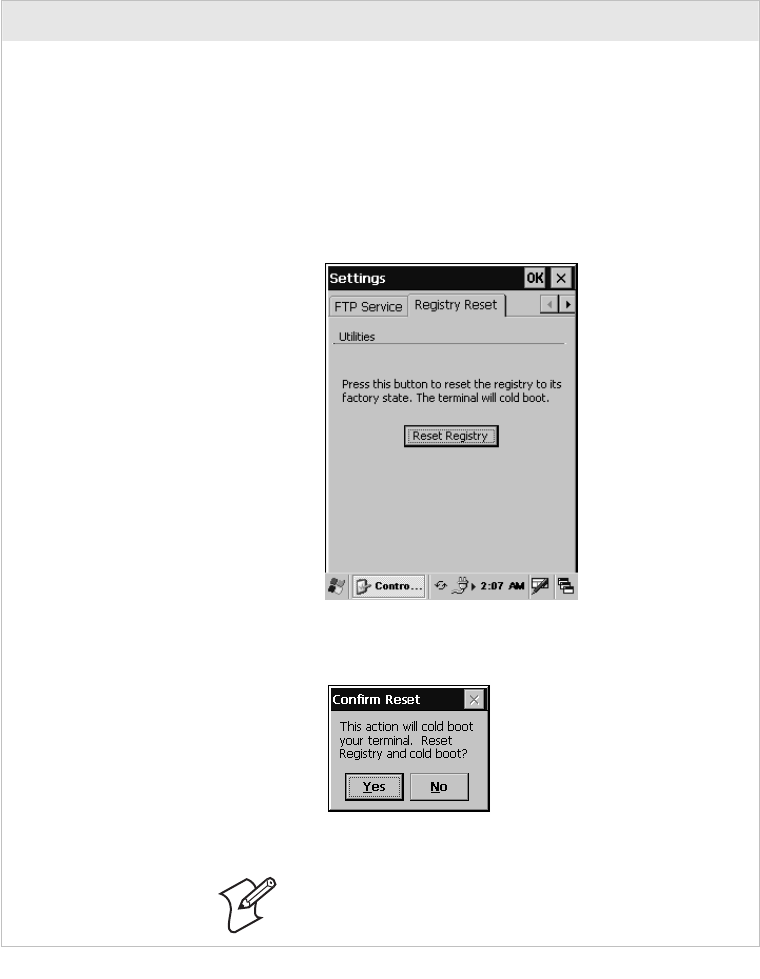
Chapter 5 — Troubleshooting and Maintaining the CN2
96 CN2 Handheld Computer User’s Manual
Problems While Operating the CN2 (continued)
Problem Solution
The CN2 exhibits unexpected
behavior after you install or
remove an application.
You may need to reset the registry and clear the object
store. Follow these steps:
1 Tap Start > Control Panel.
2 Double-tap the Utilities icon. The Settings window
appears.
3 Tap the right arrow button ( R ) once and tap the
Registry Reset tab.
4 Tap the Reset Registry button. The Confirm Reset
message appears.
5 Tap Yes. The registry is reset and the CN2 cold boots.
Note: You can also use this procedure to return the CN2
to its default software configuration.

Chapter 5 — Troubleshooting and Maintaining the CN2
CN2 Handheld Computer User’s Manual 97
Problems While Configuring Security
Problem Solution
The CN2 does not appear to be
authenticating and a Network
Connection icon ( or )
does not appear on the status bar.
The CN2 may not be communicating with your
access point. Make sure the network name on the
CN2 is the same as the network name (SSID) of the
access point that you are trying to communicate with.
The default network name is “INTERMEC.”
The 802.1x security network may not be active.
Make sure that the server software is properly loaded
and configured on the server PC. For help, see the
documentation that shipped with your server
software.
A Network Connection icon (shown
above) appears in the status bar, but
it disappears.
The CN2 may not be communicating with the access
point that you want it to communicate with. Make
sure that the network name on the CN2 is the same
as the network name of the access point that you are
trying to communicate with. The default network
name is “INTERMEC.”
The access point that you are trying to communicate
with may not be communicating with the server.
Make sure your access point is turned on, properly
configured, and has 802.1x security enabled.
The CN2 indicates that it is not
authenticated.
Make sure that:
• The User Name and Password parameters on your
CN2 match the user name and password on your
authentication server. You may need to re-enter
the password on both your CN2 and the
authentication server.
• On your authentication server, the user and group
are allowed and the group policy is allowed to log
in to the server. For help, see the documentation
for your authentication server software.
• The IP address and secret key for your access
point must match the IP address and secret key on
your authentication server. You may need to re-
enter the IP address and secret key on both your
access point and authentication server.
• The authentication server software is running on
the server PC.

Chapter 5 — Troubleshooting and Maintaining the CN2
98 CN2 Handheld Computer User’s Manual
Problems While Configuring Security (continued)
Problem Solution
The CN2 indicates that it is
authenticated, but it does not
communicate with the host.
Make sure that the CN2 IP address, host IP address,
subnet mask, and default router are properly
configured for your network.
You receive a message saying, “The
server certificate has expired or your
system date is incorrect” after you
cold boot the CN2.
The date and time on the CN2 are not saved through
a cold boot. You need to re-enter the date and time
and then save your changes. For help, see Step 4 on
page 106.
You are setting up multiple access
points in a network, with different
SSIDs, and the connection fails.
The CN2 does not save WEP key values when you
change the SSID. Re-enter the WEP key value after
you change the SSID and save your changes. You
should now be able to connect to the different access
points.
Problems With Wireless Connectivity
Problem Solution
A Network Connection icon (
or ) appears on the status bar, but
the host computer is not receiving any
data from the CN2.
In a UDP Plus network, there may be a problem
with the connection between the Intermec
Application Server and the host computer. Check
with your network administrator or see the user’s
manual for the Intermec Application Server.
In a TCP/IP network, there may be a problem with
the connection between the access point and the
host computer. Check with your network
administrator or use your access point user’s manual.
When you turn on the CN2 after it
was suspended for a while (10-15
minutes or longer), it can no longer
send or receive messages over the
network.
The CN2 may not be recognizing the network card.
Turn off the CN2, and then turn it on again.
The host may have deactivated or lost your current
terminal emulation session. In a TCP/IP direct
connect network, you need to turn off the “Keep
Alive” message (if possible) from the host so that the
TCP session is maintained while a CN2 is
suspended.

Chapter 5 — Troubleshooting and Maintaining the CN2
CN2 Handheld Computer User’s Manual 99
Problems With Wireless Connectivity (continued)
Problem Solution
The CN2 is connected to the Intermec
Application Server or host computer
and you move to a new site to collect
data. A Network Connection icon was
visible but now the no network
connection icon ( ) is visible.
You may have gone out of range of an access point.
Try moving closer to an access point or to a different
location to re-establish communications. Once you
are in range again, the network connection icon
appears again. Any data you collected while out of
range is transmitted over the network.
The no network connection icon
(shown above) appears on the status
bar.
The no network connection icon appears in three
situations:
• The CN2 may not have an IP address. You must
configure an IP address for the CN2 or make
sure that DHCP assigned an address. Use
Intermec Settings and select the radio tab to
make sure an IP address has been assigned. For
help, see “Configuring the CN2 Locally With
Intermec Settings” on page 36.
• The CN2 may not be connected to the access
point. Try these possible solutions in order:
• Make sure the access point is turned on and
operating.
• Make sure you are not using the CN2 out of
range of an access point. Try moving closer to
an access point to re-establish
communications.
• Make sure the CN2 is configured correctly for
your network. The radio parameters on the
CN2 must match the values set for all access
points the CN2 may communicate with. For
help, see “Configuring 802.11b/g Radio
Communications” on page 47.
• If you have an 802.11b/g radio, the radio
initialization process may have failed. Try
resetting the CN2. For help, see “Booting the
CN2” on page 104.
• If you have tried these possible solutions and the
no network connection icon still appears, you
may have a defective radio card. For help, contact
your local Intermec service representative.

Chapter 5 — Troubleshooting and Maintaining the CN2
100 CN2 Handheld Computer User’s Manual
Problems While Scanning Bar Codes
Problem Solution
You cannot see a red beam of light
from the scanner when you press the
Scan button or one of the Side Scan
buttons and aim the scanner at a bar
code label.
There are three possible problems:
• You may be too far away from the bar code label.
Try moving closer to the bar code label and scan
it again.
• You may be scanning the bar code label “straight
on.” Change the scanning angle and try again.
• The PSM files may not be correctly installed. For
help, see “Upgrading the Persistent Storage
Manager Files” on page 109.
You can test the effective range of the scanner. Move
within 61 cm (2 ft) of a wall and test the scanner.
You need to be within the scanning range to scan
bar code labels. For help scanning bar codes, see
“Scanning Bar Codes” on page 25.
When you release the Scan button or
Side Scan button, the Good Read
light does not turn off.
The Good Read light will remain on if you
configure the CN2 to use continuous/edge
triggering. If you configure the CN2 for level
triggering and the Good Read light remains on,
there may be a problem. Press the Scan button or
one of the Side Scan buttons again without
scanning a bar code label. If the light is still on,
contact your local Intermec service representative.
The scanner will not read the bar code
label.
Make sure you aim the scanner beam so it crosses
the entire bar code label in one pass.
The angle you are scanning the bar code label may
not be working well, or you may be scanning the
label “straight on.” Try scanning the bar code label
again, but vary the scanning angle.
The bar code label print quality may be poor or
unreadable. To check the quality of the bar code
label, try scanning a bar code label that you know
will scan. Compare the two bar code labels to see if
the bar code quality is too low. You may need to
replace the label that you cannot scan.

Chapter 5 — Troubleshooting and Maintaining the CN2
CN2 Handheld Computer User’s Manual 101
Problems While Scanning Bar Codes (continued)
Problem Solution
The scanner will not read the bar code
label (continued).
Make sure the bar code symbology you are scanning
is enabled. Use Intermec Settings to check the
symbologies. If your bar code symbology is disabled,
enable it and then try scanning the bar code label
again.
Note: If you restored the CN2 to factory default
settings, some of the symbologies may have been
disabled.
Make sure that the application you are running on
the computer is expecting input from a bar code.
You may need to use the input panel to enter this
information instead of scanning it.
The scanner does not read the bar
code labels quickly, or the scanning
beam seems to be faint or obscured.
The scanner window may be dirty. Clean the
window with a solution of ammonia and water.
Wipe dry. Do not allow abrasive material to touch
the window.
You scan a valid bar code label to
enter data for your application. The
data decoded by the CN2 does not
match the data encoded in the bar
code label.
The computer may have decoded the bar code label
in a symbology other than the label’s actual
symbology. Try scanning the bar code label again.
Make sure you scan the entire label.
To operate the computer quickly and efficiently,
you should only enable the bar code symbologies
that you are going to scan.

Chapter 5 — Troubleshooting and Maintaining the CN2
102 CN2 Handheld Computer User’s Manual
Running Diagnostics
You can run Intermec Diagnostics to determine if there are any
problems with your CN2. You can run Intermec Diagnostics at
any time, even while running an application.
To run Intermec Diagnostics
1 Tap Start > Settings > Control Panel.
2 Double-tap the Intermec Diagnostics icon.
3 From the Select test drop-down list, choose which diagnostic
test to run. There are two ways to choose a test:
• You can tap the test.
• You can type the number of the test on the numeric
keypad or the USB keyboard.
For help deciding which tests to run, see the following table,
“Summary of Intermec Diagnostics Tests.”
4 When you have finished running tests, press ESC to exit.
Note: You can exit Intermec Diagnostics at any time by
pressing ESC. You may need to press ESC to exit the current
test and then press ESC again to exit Intermec Diagnostics.
Summary of Intermec Diagnostic Tests
Test Name Description Tips
1. Backlight Test Verifies that the backlight is
working properly by turning it
off, on, and testing each dim
level.
When you start the Backlight
Power Control test, the
backlight turns off.
Tap near the top of the screen to
turn the backlight on again so
you can indicate if the test
passed or failed.

Chapter 5 — Troubleshooting and Maintaining the CN2
CN2 Handheld Computer User’s Manual 103
Summary of Intermec Diagnostic Tests (continued)
Test Name Description Tips
2. Battery Information Displays the charge levels for the
main battery and the backup
battery. Also indicates if AC
power is detected.
Tap X to exit the test.
3. Display Test Verifies that every pixel on the
CN2 screen is working properly.
When each test action begins, a
message explains what you
should see on this test display.
Press Enter or tap X to dismiss
each message. Press Enter or tap
the screen you finish examining
each test display.
4. Hardware
Configuration
Reads, verifies, and displays
information about the hardware
configuration. Also displays the
version of the operating system
(OS) running on your CN2.
You may be asked to provide
this information if you contact
Intermec Product Support.
Tap X to exit the test.
5. Memory
Information
Displays information about the
RAM, which is divided into
program memory and storage
memory.
Tap X to exit the test.
6. Networking Test Displays your IP address and
validates your network
connection.
Tap X to exit the test.
7. Audio Test Verifies that the audio sounds
are working correctly.
Tap X to exit the test.
8. Touch Screen Test Verifies that the touch screen is
working correctly.
A message directs you to draw
on the screen with the stylus.
Tap X to dismiss the message,
and a white screen appears for
you to draw on. When you
finish drawing, press any key to
exit. If the message appears
again, tap X at the top of the
screen to exit the test.
9. LED Test Verifies that the LED is working
correctly.
Tap X to exit the test.
10. Keypad Test Verifies that each key is working
correctly.
Tap X to exit the test.
Chapter 5 — Troubleshooting and Maintaining the CN2
104 CN2 Handheld Computer User’s Manual
Sending the CN2 to Intermec for Service
If you send the CN2 in for service, it is your responsibility to
save the computer data and configuration. Intermec is
responsible only for ensuring that the keypad and other
hardware features match the original configuration when
repairing or replacing your computer.
For help understanding your warranty and finding help, see
“Global Services and Support” on page xi.
You may be asked for the version of the operating system
running on your CN2. For help finding this information, see
the Hardware Configuration test in the previous section,
“Running Diagnostics.”
Booting the CN2
You seldom need to warm or cold boot the CN2. The CN2 uses
the configuration currently saved in flash memory during the
boot process.
You need to boot the CN2 when an application is locked up and
will not respond, when you upgrade the firmware, or when you
reflash the computer. The next instructions explain how you
warm and cold boot the CN2.
Warm Booting the CN2
If your charged CN2 does not resume after pressing the Power
key, or if the computer or an application is locked up, you may
need to warm boot it.
The following procedures explain the two ways to warm boot
the CN2:
• Using the Warm Boot button
• Using the Power key
To warm boot the CN2 using the Warm Boot button
• Using the end of the stylus, press the Warm Boot button
inside of the stylus holder.
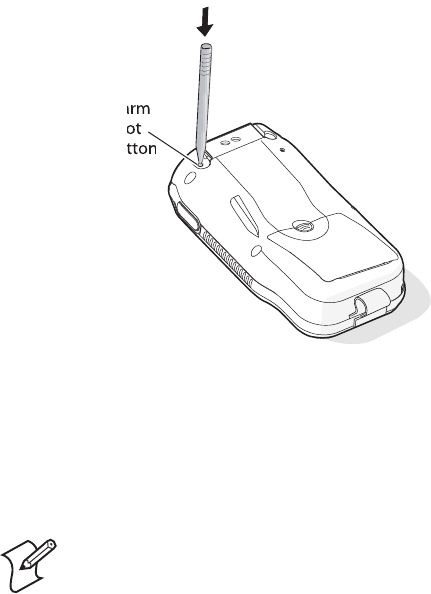
Chapter 5 — Troubleshooting and Maintaining the CN2
CN2 Handheld Computer User’s Manual 105
W
a
B
oo
but
The screen goes blank immediately. The screen remains blank
for a few seconds, the Refreshing the File System dialog box
appears, and the CN2 warm boots.
To warm boot the CN2 using the Power key
1 Press and hold the Power key for approximately 10 seconds.
Note: After about 5 seconds, the backlight toggles (turns on
or off). Keep holding the Power key for another 5 seconds
until the backlight flashes.
2 Release the Power key. The screen remains blank for a few
seconds, the Refreshing the File System dialog box appears,
and the CN2 warm boots.
Cold Booting the CN2
If the CN2 or application is locked up and does not respond to a
warm boot, follow this procedure to perform a cold boot. When
you perform a cold boot, all data in your RAM storage is deleted
and applications installed in the object store are deleted.
To cold boot the CN2
1 Open the battery door and remove the battery. For help, see
“Removing the Battery” on page 8.
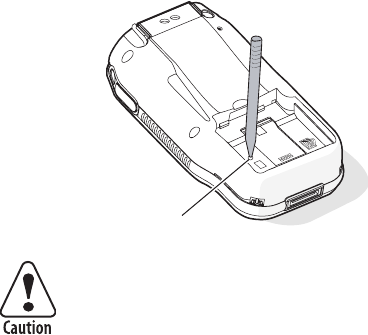
Chapter 5 — Troubleshooting and Maintaining the CN2
106 CN2 Handheld Computer User’s Manual
2 Using the end of the stylus, press the Reset button on the
inside of the battery compartment.
Reset
button
Do not use force or a sharp object when pressing the
Reset button. You may damage the Reset button.
Attention: N’employez pas la force ou un objet pointu
quand appuyant sur le remettez à zéro le bouton. Vous
pouvez endommager le remettez à zéro le bouton.
Vorsicht: Keine Gewalt anwenden oder scharfe
Gegenstände verwenden, um die Rücksetztaste zu
drücken. Das könnte die Rücksetztaste beschädigen.
3 Install the battery and battery door. After approximately 4
seconds, the CN2 starts the power on sequence.
4 The date and time settings are not saved through a cold boot.
You need to reset the time and date:
a Tap Start > Settings > Control Panel.
b Double-tap the Date/Time icon.
c Set the date and time.
d Tap OK to save the new time and date.
e Tap X to exit Date/Time.
f Tap X to exit Control Panel.

Chapter 5 — Troubleshooting and Maintaining the CN2
CN2 Handheld Computer User’s Manual 107
Upgrading the CN2
When you upgrade your CN2, you are updating these two
components:
• Operating system (OS)
• Persistent Storage Manager (PSM) files
Upgrading the Operating System
When you upgrade the operating system, you erase the current
configuration and replace it with the new default configuration.
You will need to set the network communications parameters on
the CN2 to reestablish communications with the other devices
in the wireless network.
To upgrade the OS, you need:
• an SD card formatted as FAT16.
Note: The CN2 currently supports SanDisk SD cards only.
Intermec cannot guarantee that other SD cards will work
with the CN2.
• an SD card reader.
• the latest upgrade ZIP file. This file is available from the
Intermec web site at www.intermec.com. Go to Service &
Support > Downloads. Make sure the file you select is for
your language and that it has an SD at the end of the file
name.
To upgrade the operating system
1 Download the latest upgrade ZIP file from the Intermec web
site to your desktop PC.
2 Unzip the files on your desktop PC.
3 Place the SD card in the SD card reader.
4 Copy the nk.bin and eboot.bin files to your SD card. Place
the files in the SDMMC Disk folder.
5 Open the battery door and remove the battery. For help, see
“Removing the Battery” on page 8.
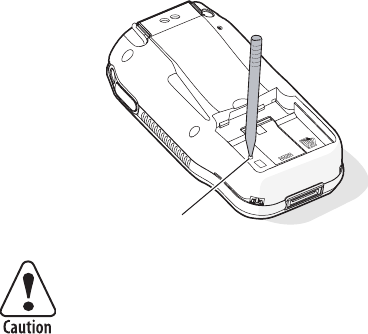
Chapter 5 — Troubleshooting and Maintaining the CN2
108 CN2 Handheld Computer User’s Manual
6 Insert the SD card into the CN2. For help, see “Increasing
File Storage With the Optional SD Card” on page 26.
7 Using the end of the stylus, press the Reset button on the
inside of the battery compartment.
Reset
button
Do not use force or a sharp object when pressing the
Reset button. You may damage the Reset button.
Attention: N’employez pas la force ou un objet pointu
quand appuyant sur le remettez à zéro le bouton. Vous
pouvez endommager le remettez à zéro le bouton.
Vorsicht: Keine Gewalt anwenden oder scharfe
Gegenstände verwenden, um die Rücksetztaste zu
drücken. Das könnte die Rücksetztaste beschädigen.
8 Hold down a key while you install the battery:
• On the numeric keypad, hold down the 8 key while you
install the battery. Do not release the 8 until the CN2
Bootloader Menu appears.
• On the scroll keypad, hold down the D key while you
install the battery. Do not release the D until the CN2
Bootloader Menu appears.
9 Install the battery door and place the CN2 in a
communications dock.
10 Select Update OS + Bootloader from the menu:
• On the numeric keypad, use the 8 key as a down arrow
and the 2 key as an up arrow to select Update OS +
Bootloader and then press Enter.

Chapter 5 — Troubleshooting and Maintaining the CN2
CN2 Handheld Computer User’s Manual 109
Note: The 8 and 2 keys on the numeric keypad will
function as arrow keys only until the OS loads.
• On the scroll keypad, use the D and U keys to select
Update OS + Bootloader and then press Enter.
Messages about the download status appear at the bottom of
the screen. The “Need Reboot” message appears and Cold
Boot is selected.
11 Press Enter. The CN2 cold boots and the Refreshing File
System status box appears.
12 If the Confirm File Replace dialog box appears, tap Yes To
All. The CN2 finishes rebooting, and your operating system
is updated.
Upgrading the Persistent Storage Manager Files
To upgrade the Persistent Storage Manager (PSM) files for your
CN2, you need:
• the device upgrade ZIP file containing the PSM files. This file
is available from the Intermec web site at www.intermec.com.
Go to Service & Support > Downloads.
• an SD card reader.
To upgrade the PSM files
1 Copy the device upgrade ZIP file to your PC, and unzip the
PSM files. You should see these folders:
• 2577
• DOCImage
2 Remove the SD card from the CN2 and place it in the SD
card reader. For help, see “Increasing File Storage With the
Optional SD Card” on page 26.
3 Copy the 2577 and DOCImage folders to the SD card.
4 Install the SD card in your CN2.
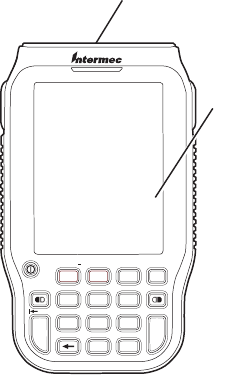
Chapter 5 — Troubleshooting and Maintaining the CN2
110 CN2 Handheld Computer User’s Manual
5 Cold boot your CN2. For help, see “Cold Booting the CN2”
on page 105. A dialog box appears telling you that it is
updating the PSM. When this process is complete, the CN2
cold boots again and installs the files.
After the CN2 cold boots, the Refreshing the File System
dialog box appears. Your CN2 is loaded with the new PSM
files.
6 Remove the SD card.
Cleaning the Scanner Window and the Touch Screen
To keep the computer in good working order, you may need to
clean the scanner window and touch screen with a solution of
ammonia and water.
CN2
T
A
B
0
.
79
13
46
8
2
5
ESC
E
N
T
E
R
F1 F3 LockF2
F4 F6F5
F7 F9F8
F12F10 F11
DEF CapsABC
GHI MNOJKL
PQRS WXYZTUV
Space Alt
Scanner window
Touch screen
Cleaning the CN2: You can clean the scanner window and the touch screen
as often as needed for the environment in which you are using the computer.
You can help keep the touch screen clean by using the stylus, instead of your
fingertip, to tap the screen.

Chapter 5 — Troubleshooting and Maintaining the CN2
CN2 Handheld Computer User’s Manual 111
There are no user-serviceable parts inside the CN2. Opening
the unit will void the warranty and may cause damage to the
internal components.
Attention: Le CN2 ne contient pas de pièces réparables par
l’utilisateur. Le fait d’ouvrir l’unité annule la garantie et peut
endommager les pièces internes.
Vorsicht: Im Modell CN2 gibt es keine Teile, die vom
Benutzer gewartet werden können. Wenn das Gerät geöffnet
wird, macht das die Garantie nichtig und kann die internen
Komponenten beschädigen.
To clean the scanner window and touch screen
1 Press and hold the Power key for 2 to 3 seconds, and then
release it to turn off the CN2.
2 Dip a clean towel or rag in the ammonia solution and wring
out the excess. Wipe off the scanner window and touch
screen. Do not allow any abrasive material to touch these
surfaces.
3 Wipe dry.
To clean the scanner window
• You can use the CN2 Screen Cleaner Kit (P/N 346-065-101)
to clean the scanner window.
Chapter 5 — Troubleshooting and Maintaining the CN2
112 CN2 Handheld Computer User’s Manual

CN2 Handheld Computer User’s Manual 113
Specifications and
Accessories
A
Appendix A — Specifications and Accessories
114 CN2 Handheld Computer User’s Manual
Physical and Environmental Specifications
Use this section to find technical information about the CN2
and its available features and options.
Physical Dimensions
Length: 14.7 cm (5.8 in)
Width: 8.6 cm (3.4 in)
Thickness: 3.5 cm (1.4 in)
Weight: 370 g (11.9 oz)
Power and Electrical Specifications
Operating: Rechargeable 2150 mAh lithium-ion battery
Backup: Rechargeable NiMH 20 mAh battery
Electrical rating: x 3.7 V; 1.5 A peak
Temperature and Humidity Specifications
Operating: 0°C to 50°C (32°F to 122°F)
Storage: -10°C to 50°C (14°F to 122°F)
Charging: 0°C to 45°C (32°F to 113°F)
Humidity: 5% to 95% relative humidity, non-
condensing
Environmental rating: IP64
Screen Specifications
• RGB 240 x 320 pixels
• 8.9 cm (3.52 in) diagonal square active area, ¼ VGA
Keypads
• 18-key numeric keypad
• 10-key scroll keypad

Appendix A — Specifications and Accessories
CN2 Handheld Computer User’s Manual 115
Bar Code Symbologies
• Codabar • Interleaved 2 of 5
• Code 39 • UPC/EAN
• Code 128 • MSI
1D Linear Imager Reading Distances
This table contains reading distance on the 1D line.
Symbology
Density (mm)
Density (mil)
Min
(mm)
Max
(mm)
Min
(inch)
Max
(inch)
Code 39 0.1 4 95 136 3.7 5.4
0.3 12 45 240 1.8 9.4
0.5 20 44 300 1.7 11.8
1 39 120 400 4.7 15.7
EAN 0,33 mm/
100% contrast
13 mils/
100% contrast
45 240 1.8 9.4
0,33 mm/
25% contrast
13 mils/
25% contrast
61 157 2.4 6.2
Accessories for the CN2
You can use these accessories (sold and ordered separately) with
the CN2. To order accessories, contact your local Intermec sales
representative.
CN2 Battery (P/N 074201)
Use the lithium-ion battery to provide main power to the
computer.
CN2 Universal Power Supply (P/N 074246-002)
Use this power supply to provide power to the CN2 and charge
its battery when it is in the CN2 communications dock or CN2
modem dock.

Appendix A — Specifications and Accessories
116 CN2 Handheld Computer User’s Manual
CN2 Universal Power Supply with Hirose Connector
(P/N 074246-003)
Use this power supply to provide power to the CN2 and charge
its battery. You connect this power supply directly to the Hirose
connector on the CN2
CN2 Car Charger (P/N 225-706-001)
Use this power supply to provide power to the CN2 and charge
its battery while in the car. You connect one end of this power
supply directly to the Hirose connector on the CN2, and
connect the other end to the car lighter jack. The battery is fully
charged in about 4 hours.
You must use only the Intermec power supply approved for
use with the CN2. Using any other power supply will
damage the CN2.
Attention: Vous devez utiliser seulement le bloc
d’alimentation Intermec désigné pour le CN2. L’utilisation
d’autre blocs d’alimentation endommagera le CN2.
Vorsicht: Mit dem Modell CN2 darf nur der dazu
genehmigte Intermec-Netzteil verwendet werden. Die
Verwendung eines anderen Netzteils wird das Modell CN2
beschädigen.
CN2 Communications Dock (P/N 225-696-001)
Use the communications dock to charge your battery, to provide
power to your CN2, and to communicate through a USB
connection.
CN2 Modem Dock (P/N 075499-001)
Use the modem dock to communicate through a modem
connection, to communicate through a USB connection, to
charge your battery, to provide power to the CN2, and to attach
a USB keyboard to the CN2.
USB Type B Interface Cable (P/N 321-576-002)
Use the USB Type B interface cable with the communications
dock and modem dock to transfer data and applications through
a USB connection.
Appendix A — Specifications and Accessories
CN2 Handheld Computer User’s Manual 117
CN2 Two-Wire Phone Cord (P/N 074326)
Use the 2-wire phone cord with the modem dock.
CN2 Serial Adapter (P/N 074247)
Use the serial adapter to turn the 16-pin serial port (COM1) on
the CN2 into a DB9 (9-pin) male serial connector that you can
connect to a serial printer. For help connecting the serial adapter
to another device, see the “Serial Port Settings” table on
page 122.
CN2 Handstrap (P/N 075400)
Use the handstrap for a comfortable way to hold the CN2 for
extended periods of time.
CN2 Holster (P/N 074490)
Use the holster for a convenient way to carry the CN2 when you
are not using it.
CN2 Dust Cover (P/N 074103)
Use the dust cover to protect the CN2 keypad in dusty
environments.
CN2 Screen Protector Kit (P/N 346-065-005)
Use the screen protector kit to attach a protective film directly to
the CN2 touch screen. The kit contains 25 protective films.
CN2 Screen Cleaner Kit (P/N 346-065-101)
Use the screen cleaner kit to clean the CN2 touch screen.
CN2 Replacement Stylus Kit (P/N 075405)
Use this kit to replace your lost stylus. The kit contains 5
replacement styli.
Appendix A — Specifications and Accessories
118 CN2 Handheld Computer User’s Manual

CN2 Handheld Computer User’s Manual 119
Default Configuration
B

Appendix B — Default Configuration
120 CN2 Handheld Computer User’s Manual
Default Configuration
Use the following tables to see the default configuration settings
of the CN2. If you restore the CN2 to factory default settings, it
will use these values. The tables are organized according to the
options in Intermec Settings.
Default Scanner Configuration
Symbology Default Value
Codabar Enabled
Code 39 Enabled
Code 128 Enabled
Interleaved 2 of 5 Enabled
MSI Enabled
UPC/EAN Enabled
Symbology Options Default Value
Preamble No characters (disabled)
Postamble No characters (disabled)
Global Symbology ID Disable
Virtual Wedge Settings Default Value
Virtual Wedge Enabled
Grid No characters (disabled)

Appendix B — Default Configuration
CN2 Handheld Computer User’s Manual 121
Default Communications Configuration
Communications Settings Default Value
DHCP Enable
Current Device IP Address 127.0.0.1
Primary DNS 0.0.0.0
Secondary DNS No characters (disabled)
Primary WINS 0.0.0.0
Secondary WINS No characters (disabled)
802.11 Radio Settings Default Value
Security Settings
Security Choice
Active Profile
Funk Security
Profile 1
Profile 1
Network Type
Channel
Network name (SSID)
Power Management
Authentication
Association
Encryption
Network Key Index
User Name
Password prompt
User Password
Inner Authentication - TTLS
Inner Authentication - PEAP
Inner EAP
Validate Server Certificate
Mixed Cell
Logging
Detect Rogue APs
Infrastructure
3
INTERMEC
Enabled (PSP)
None
Open
None
Key 1
anonymous
Disabled
No characters (disabled)
MS-Chapv2
EAP/MS-Chapv2
EAP/MD5
No
On
Off
Off
Radio Power Management Disabled (CAM)
Device Name WindowsCE

Appendix B — Default Configuration
122 CN2 Handheld Computer User’s Manual
UDP Plus Settings Default Value
UDP Plus Activate Disabled
Controller IP 0.0.0.0
Controller Port 5555
Ack Delay Upper Limit 5000 ms
Ack Delay Lower Limit 300 ms
Retries 7
Send Timer 20 sec
Receive Timer 45 sec
Note: The default Serial Port Settings are listed in the following
table. An application can change these settings.
Serial Port Settings Default Value
Baud Rate 115200
Data Bits 8
Parity N
Stop Bit 1
Flow Control None
Default Device Settings Configuration
Device Settings Default Value
Beeper Volume Very high
Backlight Timeout 1 minute
Power Management
User Idle
System Idle
Suspend
1 minute
1 minute
1 minute

CN2 Handheld Computer User’s Manual 123
Index
I

Index
124 CN2 Handheld Computer User’s Manual
Symbols and Numbers
A See Backspace key
See Caps Lock icon
See Green key
See Green mode
See Network Connection icon
See Orange key
.cab file
using to install applications, 84
using to make applications persist
through cold boot, 90
.NET Compact Framework, 3, 82
10-key scroll keypad, illustrated, 13
115200 bps, modem dock maximum, 73
18-key numeric keypad, illustrated, 11
1D linear imager
determining if installed, 4
reading distances, 115
802.11b/g radio
communications, configuring, 47
determining if installed, 4
Wi-Fi certified, 2
802.1x security
configuring
overview, 59
with Funk, 60
with Microsoft, 61
troubleshooting, 97 to 98
A
abrasive material, avoiding, 111
AC power source, unavailable, 30
AC power supply, accessory described, 115
accessing F1 to F12, 11
accessing F3 to F5, 13
accessories, described, 115
Active Applications icon, illustrated, 24
Active Applications List
illustrated, 24
using to manage tasks, 24
ActiveSync
installing and establishing a partnership,
85
troubleshooting, 87
using to copy and install files, 87
using to install applications, 85
ammonia and water for cleaning, 110
antenna restrictions, 47
applications
deleted during cold boot, 90
developing
web-based, 83
with Resource Kits, 82
installed by default, 3
installing with
ActiveSync, 85
Avalanche, 89
SD card, 89
launching automatically, 91
persisting through cold boot, 90
problems after installing/removing, 96
running several simultaneously, 22
storing on the CN2, 84
Arrow keys, illustrated, 13
attachments, downloading in email, 80
audio feedback, See beeps
Audio Test, diagnostics, 103
Authentication server, properly configured,
52
authentication, troubleshooting 802.1x
security, 97 to 98
automatically launching your application,
91
Avalanche, See Wavelink Avalanche
Avalanche Enabler, password for exiting,
89
B
backlight
Backlight Test, diagnostics, 102
Backlight Timeout recommendations,
10
toggling on or off, 14
Backlight Test, diagnostics, 102
Backspace key, using to delete characters,
12
backup battery, time limit, 5
bar codes
Good Read light, 21
scanning
determining if available, 4
how to, 25
Index
CN2 Handheld Computer User’s Manual 125
bar codes, scanning (continued)
reading distances, 115
troubleshooting, 100
supported symbologies, 115
symbologies, default, 25
test bar code, 26
batch CN2, defined, 4
battery
accessory, described, 115
Battery Information, diagnostics, 103
charging, 6
checking status, 10
described, 115
disposing of, 6
door latch, illustrated, 6
installing, 6
light
green, orange, or red, 21
illustrated, 20
maximizing life, 10
removing, 8, 28
status icons, 11
using, 5
Battery Information, diagnostics, 103
baud rate, maximum for modem dock, 73
beeps
Audio Test, diagnostics, 103
understanding, 21
volume, changing, 22
bitmap graphics, 15
booting
cold booting, 105
overview, 104
Reset button, 106
Warm Boot button, 105
warm booting, 104
buttons, illustrated
Arrow, 13
Enter, 11, 13
Green, 11
Orange, 11, 13
Power, 11, 13
Reset, 106
Scan, 2, 13
Side Scan, 2
Warm Boot, 105
C
CAB file, See .cab file
cable, USB, accessory described, 116
calibrating, touch screen, 18
Caps Lock icon, 12
car charger, accessory described, 116
card, SD
contents appear in SDMMC Disk
folder, 84
inserting, 27
removing, 28
using to install applications, 89
using to store application data, 84
CCX v1.0 certification, 3
CCX v1.0 compliance, 52
certificates
loading for security, 65
Microsoft Active Directory, 52, 65
third-party certificate authority, 66
charging, battery, 6
Cisco access point, 62
cleaning the scanner window and touch
screen, 110, 117
CN, 4
CN2
accessories list, 115
batch version, defined, 4
Bootloader Menu, 108
car charger, accessory described, 116
default configuration settings, 120 to
122
default software configuration, 96
description, 2
features, 3
hardware configuration, displayed, 103
installed applications, 3
operating system version, displayed, 103
power supply, accessory described, 115
serial port, illustrated, 2
toggling the backlight, 14
troubleshooting, guide to, 93
turning on and off, 14
upgrading, 107
USB/serial port, illustrated, 2
wireless version, defined, 4
Codabar, 25
Index
126 CN2 Handheld Computer User’s Manual
Code 128, 25
Code 39, 25
cold boot
applications deleted during, 90
defined, 105
instructions, 105
communications
default configuration settings, 121
Networking Test, diagnostics, 103
communications dock
accessory, described, 116
charging the battery, 7
green Power light, 8
Configuration number, 4
configuring
802.11b/g radio communications, 47
802.1x security
configuring, 59
troubleshooting, 97 to 98
date and time, 106
default settings, 120 to 122
LEAP security, 62
overview, 34
phone connection, 71
remotely with Intermec Settings, 40
security, 51
static WEP security, 63
TCP/IP network parameters, 48
UDP Plus network parameters, 50
USB communications, 46
using local Intermec Settings, 36
using Setup Assistant, 35
WPA security, 54
contact information for Intermec, xii
contents, in SDMMC Disk folder, 28
converting writing to text, using
Transcriber, 17
copying files to CN2 using
ActiveSync, 87
SD card, 89
Wavelink Avalanche, 89
copyright information, xv
current task, defined, 22
D
date, configuring, 106
default configuration
restoring, 39
settings, 120 to 122
default configuration of CN2 software, 96
Dell Model SK-8115 USB keyboard, 29
desktop
illustrated, 15
understanding, 16
developing applications using Resource
Kits, 82
diagnostics
running, 102
summary of tests, 102
dimensions, physical, 114
disabling security, 68
DiskOnChip folder, using to store
application data, 84
Display Test, diagnostics, 103
documentation
CN2 Communications Dock Quick Start
Guide, 7
CN2 Modem Dock Quick Start Guide,
30, 71
downloading from web, xii
Intermec Computer Command Reference
Manual, 38
MobileLAN access WA2X System
Manual, 54, 59
MobileLAN secure 802.1x Security
Solution Installation Guide, 52
drag, defined, 15
dust cover, accessory described, 117
E
eboot.bin file, 107
electrical specifications, 114
email
attachments, downloading, 80
meeting requests, downloading, 80
setting up, 78
using, 80
Enable FTP Service checkbox, 70
Enabler, password for exiting, 89
ending an active task, 24
Enroll Certificates application, 65
Enter key, illustrated, 11, 13
Enterprise mode of WPA, 54
environmental specifications, 114
Index
CN2 Handheld Computer User’s Manual 127
exiting
Avalanche Enabler, 89
Intermec Settings, 39
Extensible Authentication Protocol (EAP),
54
F
F1 to F12, accessing, 11
F3 to F5, accessing, 13
factory default settings, restoring, 39
FAT16, 107
File Transfer Protocol, See FTP
files, accessing on the SD card, 28
film, screen protector, accessory, 117
fingerprints, cleaning, 110
FTP Service tab, illustrated, 70
FTP, enabling on CN2, 70
Funk Security
configuring
802.1x security, 60
WEP, 63
WPA security, 55
WPA-PSK, 56
selecting a profile, 52
supplicant, using, 52
G
Good Read light
illustrated, 20
troubleshooting, 100
Green key
illustrated, 11
using, 12
Green mode, enabling, 12
H
handstrap, accessory described, 117
Hardware Configuration, diagnostics, 103
Hirose connector, power supply, accessory
described, 116
holster, accessory described, 117
host computer not receiving data,
troubleshooting, 98
humidity, specifications, 114
I
ICCU, See Intermec Settings
icons
Active Applications, illustrated, 24
battery status, 11
taskbar, illustrated, 15
understanding screen, 19
identifying the current task, 23
IDL, 82
imager
1D linear reading distances, 115
determining if installed, 4
IMAP4 email server, 78
Import Root utility, 65
increasing file storage with SD card, 26
inserting
battery, 6
SD card, 27
installing
ActiveSync, 85
applications using the SD card, 89
applications, problems afterward, 96
battery, 6
SD card, 27
Intel XScale processor, 3
Interleaved 2 of 5, 25
Intermec Developer Library, See IDL
Intermec Diagnostics
icon, illustrated, 102
running, 102
summary of tests, 102
Intermec SDK, See Resource Kits
Intermec Settings
exiting, 39
navigating, 37
opening on the CN2, 36
package for Wavelink Avalanche, 40
restoring default settings, 39
saving, 39
using to remotely configure, 40
Intermec telephone number, xii
Internet Explorer, opening, 83
Internet, configuring a connection to, 71
IPv6 support, 3
ISP, configuring a connection to, 71
Index
128 CN2 Handheld Computer User’s Manual
K
Keep Alive message, 98
Keyboard port on modem dock,
illustrated, 30
keyboard shortcuts, 31
keyboard, USB, installing and using, 29
keypads
dust cover, accessory, 117
numeric keypad
accessing function keys, 11
deleting characters, 12
illustrated, 11
typing characters, 12
typing uppercase characters, 12
scroll keypad
accessing function keys, 13
illustrated, 13
L
labels, scanning, 25
launching applications automatically, 91
LEAP security, configuring, 62
lights, status, described, 21
Lightweight Extensible Authentication
Protocol (LEAP), described, 62
lithium-ion battery, 5
loading certificates for security, 65
Logitech Model Y-BF37 USB keyboard,
29
M
managing multiple applications or tasks,
22
managing multiple tasks
Task Manager, using, 22
manuals
CN2 Communications Dock Quick Start
Guide, 7
CN2 Modem Dock Quick Start Guide,
30, 71
downloading from web, xii
Intermec Computer Command Reference
Manual, 38
MobileLAN access WA2X System
Manual, 54, 59
MobileLAN secure 802.1x Security
Solution Installation Guide, 52
maximizing battery life, 10
meeting requests, downloading in email,
80
Memory Information, diagnostics, 103
Microsoft Active Directory, 52, 65
Microsoft ActiveSync, See ActiveSync
Microsoft C#, 82
Microsoft Embedded Visual C++, 82
Microsoft Security
choosing, 53
configuring
802.1x security, 61
WEP, 64
WPA, 57
WPA-PSK, 58
using, 52
Microsoft Wireless Zero Configuration,
See Wireless Information tab
modem dock
accessory, described, 116
attaching USB keyboard, 29
configuring the CN2 to use, 71
maximum baud rate supported, 73
port
Keyboard, illustrated, 30
Phone, illustrated, 30
Power, illustrated, 30
USB, illustrated, 30
modes
Green mode, 12
Orange mode, 11, 13
Suspend mode, 14
MSI, 25
N
navigating in Intermec Settings, 37
network communications lost, 39
Network Connection icon, 19, 68, 97, 98,
99
network protocols supported, 47
Networking Test, diagnostics, 103
nk.bin file, 107
no network connection icon,
troubleshooting, 99
numeric keypad, using, 11
Index
CN2 Handheld Computer User’s Manual 129
O
object store, 90
operating system
displaying the version, 103
upgrading, 107
operating the CN2
humidity range, 114
temperature range, 114
troubleshooting, 94
optional features
1D linear imager, 3
802.11b/g radio, 3
keypad, 3
Orange key
illustrated, 11, 13
refreshing the selected folder, 12, 13
using, 11, 13
Orange mode, enabling, 11, 13
P
parameters, ways to configure, 34
passphrase
setting for Funk WPA-PSK, 56
setting for Microsoft WPA-PSK, 59
password for exiting Avalanche Enabler, 89
patent information, xiv
persistent applications, 90
Persistent Storage Memory (PSM),
upgrading, 109
phone connection, configuring, 71
phone cord (2-wire), accessory described,
116
Phone port on modem dock, illustrated, 30
physical
dimensions, 114
specifications, 114
POP3 email server, 78
Power key
illustrated, 11, 13
using, 14
Power port on modem dock, illustrated, 30
power specifications, 114
power supply, accessory described, 115
Pre-Shared key Mode, WPA, 54
problems, finding and solving, 94
profile, selecting for Funk security, 52
Protected Extensible Authentication
Protocol (PEAP), described, 59
PSK mode of WPA, 54
pull-tab, on an SD card, 27
R
radio
communications, configuring, 47
determining if installed, 4
Wi-Fi certified, 2
Radio Power Management parameter, 10
RAM, Memory Information, diagnostics,
103
reading distances, 1D linear imager, 115
refresh, 12, 13
registry
clearing, 96
editing entries
for .cab files, 90
for the keypad, 43
entries, described, 43, 91
location on CN2, 43, 91
resetting, 96
Remote Registry Editor, 43, 90
remotely managing the CN2, using
Avalanche, 89
removing
applications, problems afterward, 96
battery, 8, 28
SD card, 28
Reset button, illustrated, 106
Reset Registry button, 96
Resource Kits, using to develop
applications, 82
restoring default settings, 39
running several applications
simultaneously, 22
S
safety
icons, xi
summary, x
SanDisk SD cards, 26
Save icon, illustrated, 39
saving, Intermec Settings, 39
Index
130 CN2 Handheld Computer User’s Manual
Scan buttons
illustrated, 13
troubleshooting, 100
ScanDemo, using, 16
scanner
cleaning the window, 110
default configuration settings, 120
reading distances, 115
troubleshooting, 100
window, illustrated, 110
scanning bar codes, 25
described, 25
determining if available, 4
using ScanDemo application, 16
screen, See also touch screen
Backlight Test, diagnostics, 102
cleaning, 110
Display Test, diagnostics, 103
specifications, 114
Touch Screen Test, diagnostics, 103
screen cleaner, accessory described, 117
screen icons, understanding, 19
screen protector, accessory described, 117
scroll keypad, using, 13
SD card
accessing files, 28
attaching a pull-tab, 27
contents, in SDMMC Disk folder, 84
inserting, 27
removing, 28
required to upgrade operating system,
107
using to copy and install files, 89
using to install applications, 89
using to store application data, 84
using to upgrade operating system, 107
SDK, See Resource Kits
SDMMC Disk folder, using to store
application data, 84
secure digital card, See SD card
security
configuring
802.1x, 59
LEAP, 62
overview, 51
WEP, 63
WPA, 54
disabling, 68
loading certificates, 65
using Microsoft Security, 52
using the Funk supplicant, 52
viewing wireless network information,
68
security choice, Microsoft or Funk, 52
serial adapter, accessory described, 117
serial port, illustrated, 2
settings, restoring default, 39
Setup Assistant, using to configure CN2,
35
Shift key (scroll keypad), See Orange key, 1
Side Scan buttons
illustrated, 2
troubleshooting, 100
SMTP gateway, 78
soft keyboard, 37
software configuration, default, 96
sound, Audio Test, diagnostics, 103
sounds, See beeps
specifications
1D linear imager reading distances, 115
electrical, 114
humidity, 114
power, 114
screen, 114
temperature, 114
start screen
illustrated, 15
understanding, 16
static WEP security, configuring, 63
status
beeps, understanding, 21
checking battery, 10
lights, understanding, 20
status bar, See taskbar
storing your application on the CN2, 84
stylus
accessory described, 117
calibrating the touch screen, 18
using with touch screen, 15
Suspend mode, described, 14
switching between active tasks, 24, 25
SWLD26C1 configuration window, 68
Index
CN2 Handheld Computer User’s Manual 131
symbologies, bar code
default, 25
disabled incorrectly, 40, 101
supported, 115
T
tab, on an SD card, 27
tap and hold, defined, 15
tap, defined, 15
Task Manager
numeric keypad shortcut, 22
scroll keypad shortcut, 23
starting, 22, 23
using, 23
Task Manager screen, illustrated, 23
taskbar
illustrated, 15
understanding, 16
tasks, running several simultaneously, 22
TCP/IP
network diagram, 48
network, configuring parameters, 48
technical support
accessing on web, xii
sending CN2 for repair, 104
services, listed, xiii
telephone access, xiii
viewing the operating system version,
103
telephone access to technical support, xiii
temperature, specifications, 114
tests
running diagnostics, 102
summary of diagnostic tests, 102
third-party certificate authority, 66
time, configuring, 106
TKIP, using with WPA, 54
touch screen
accessories, 117
calibrating, 18
cleaning, 110, 117
icons, understanding, 19
illustrated, 110
Touch Screen Test, diagnostics, 103
using with stylus, 15
Touch Screen Test, diagnostics, 103
Transcriber, using, 17
Transport Layer Security (TLS), described,
59
troubleshooting
bar code symbologies, 101
configuring 802.1x security, 97 to 98
diagnostic tests, 102
guide to finding solutions, 93
lost network connection after suspend,
98
Network Connection icon, 97, 98, 99
operating the CN2, 94
scanning bar codes, 100
wireless connectivity, 98
trusted root certificate, 65
turn on/off the CN2, 14
U
UDP Plus
network diagram, 50
network, configuring parameters, 50
understanding
screen icons, 19
status lights, 20
unexpected behavior, 96
Unicode characters, 15
unique client certificate, 65
UPC/EAN, 25
upgrading
operating system, 107
Persistent Storage Memory (PSM), 109
USB communications
configuring, 46
network diagram, 46
USB interface cable, accessory, 116
USB Host Power parameter, 30
USB interface cable, accessory described,
116
USB keyboard
installing and using, 29
supported models, 29
USB port on modem dock, illustrated, 30
USB/serial port, illustrated, 2
User Certificates utility, 65
user-programmable fonts, 15
Index
132 CN2 Handheld Computer User’s Manual
using
battery, 5
Green key, 12
Orange key, 11, 13
Power key, 14
SD card, 26
touch screen, 15
USB keyboard, 31
Utilities icon, 31, 96
V
version, operating system, 103
viewing active tasks, 23, 24
Visual Basic .NET, 82
volume, beeper, changing, 22
W
Warm Boot button, illustrated, 105
warm booting, 104
warranty information, xii
Wavelink Avalanche
Agent, 89
package for CN2, 40
password for exiting Enabler, 89
using to copy and install files, 89
using to remotely manage the CN2, 89
WEP security, configuring, 63
Wi-Fi certified, 2
Wi-Fi Protected Access (WPA) security, 54
Windows keyboard shortcuts, 31
wireless CN2, defined, 4
wireless communications
configuring, 47
troubleshooting, 98
Wireless Information tab, 69
Wireless Zero Configuration, See Wireless
Information tab
WPA security
configuring with Funk, 55
configuring with Microsoft, 57
described, 54
WPA-PSK security
configuring with Funk, 56
configuring with Microsoft, 58
described, 54
writing on touch screen, converting with
Transcriber, 17
X, Y, Z
XScale processor, 3
yellow Power key, 14
Zero Config, See Wireless Information tab

Corporate Headquarters
6001 36th Avenue West
Everett, Washington 98203
U.S.A.
tel 425.348.2600
fax 425.355.9551
www.intermec.com
CN2 Handheld Computer User's Manual
*075464-003*
P/N 075464-003